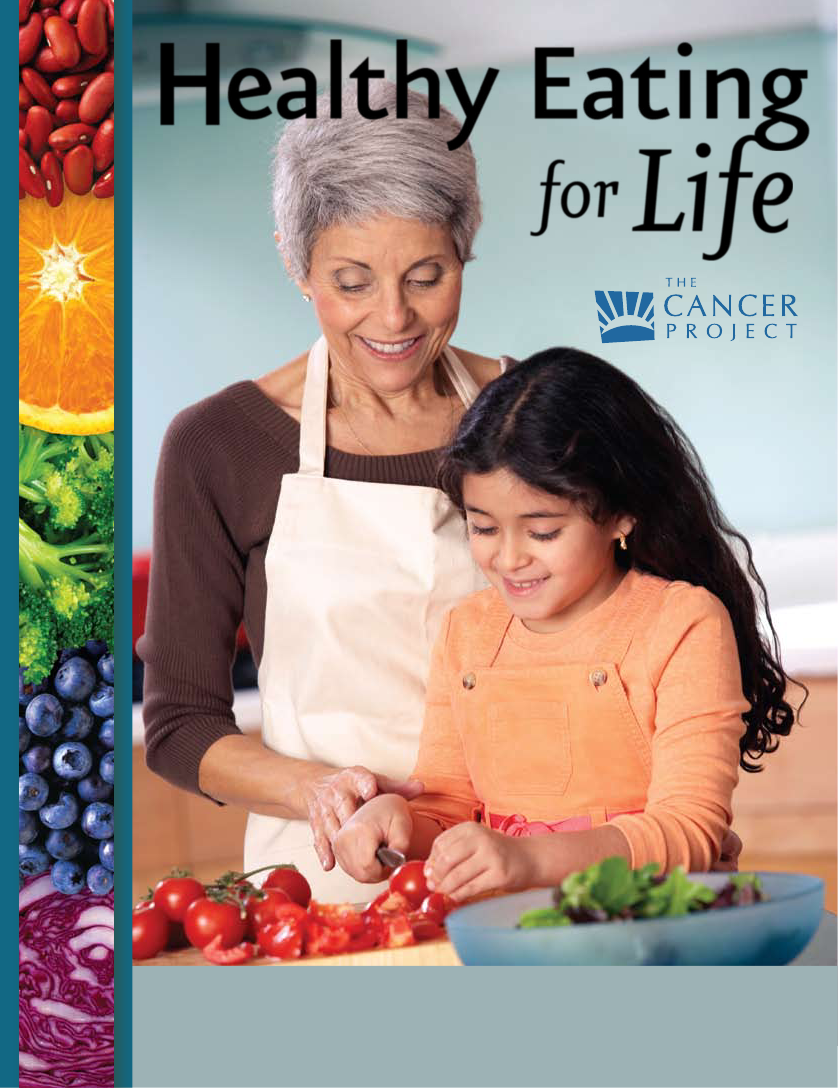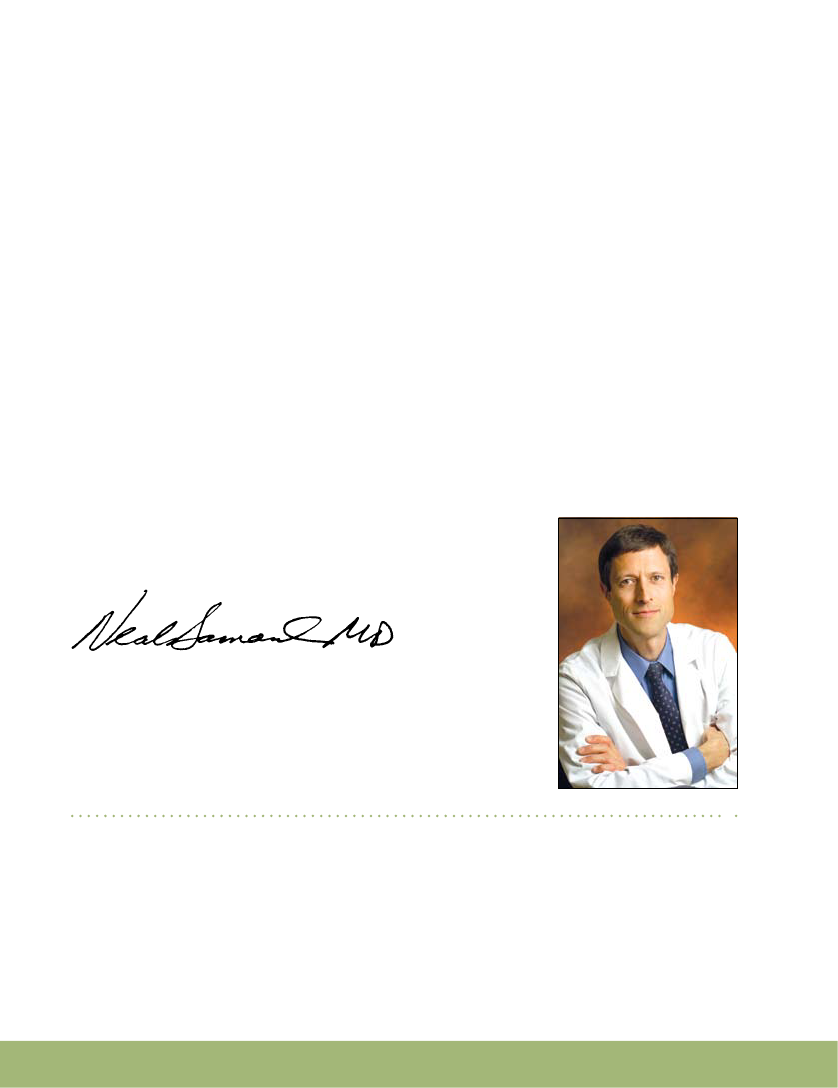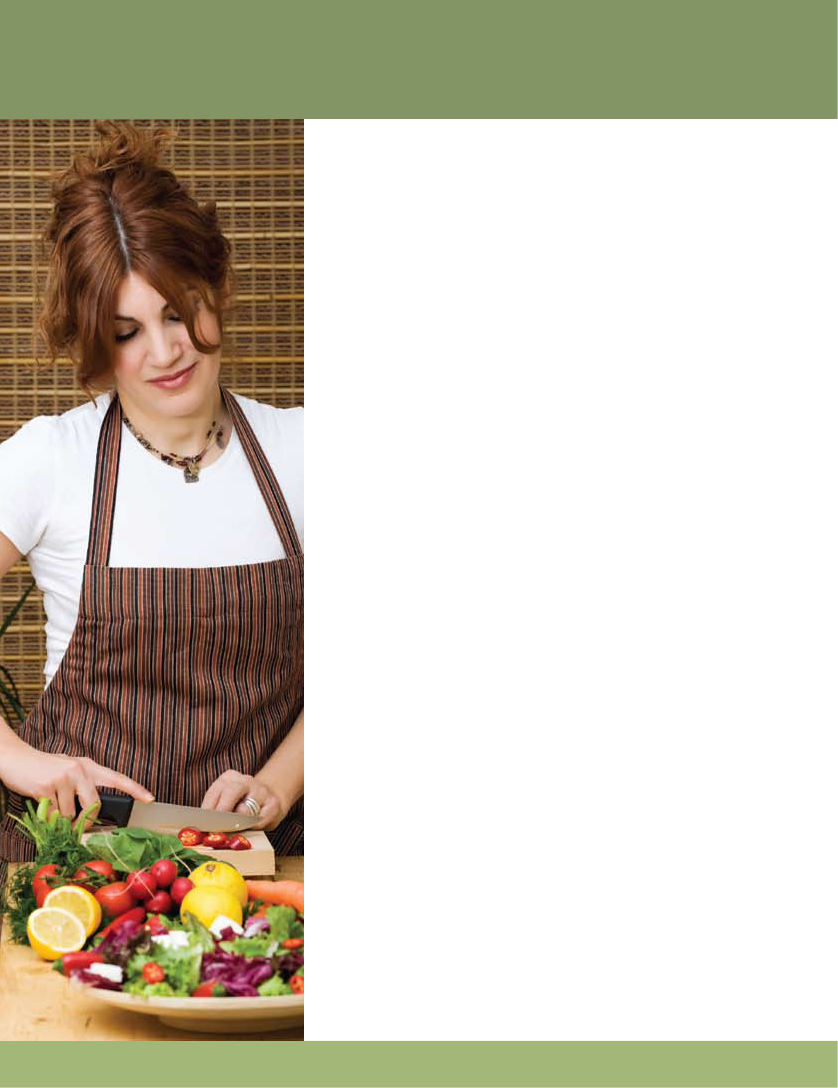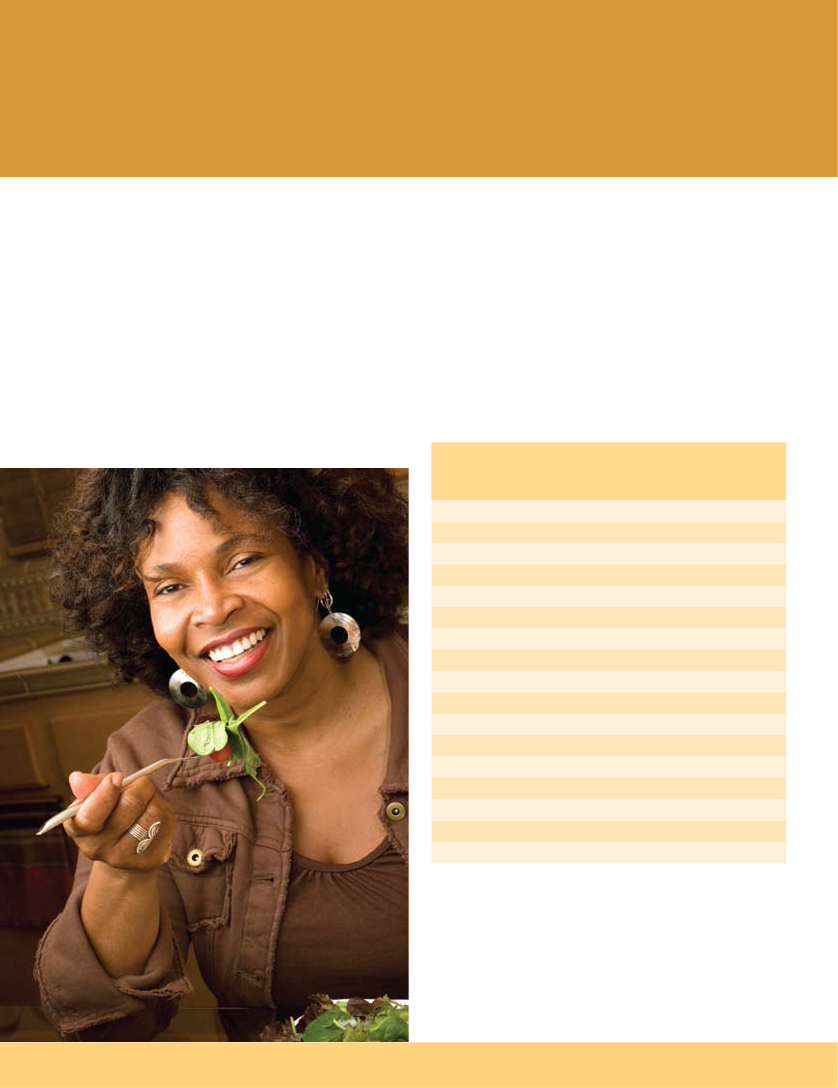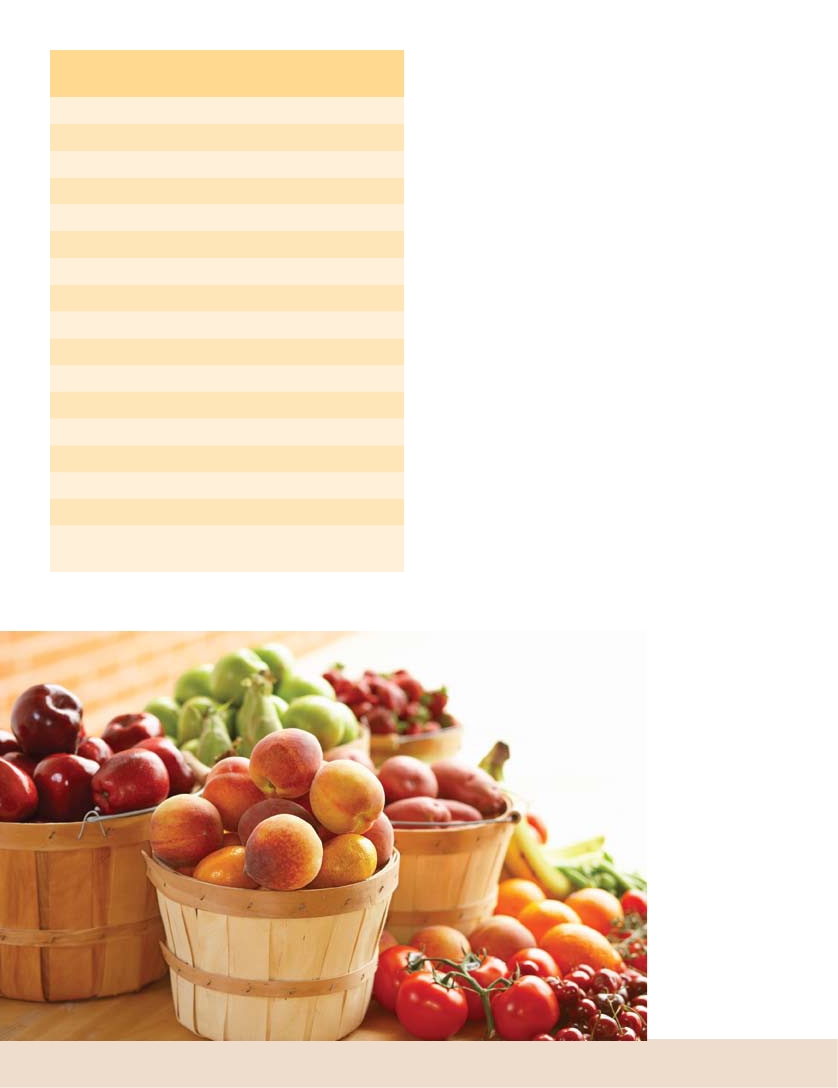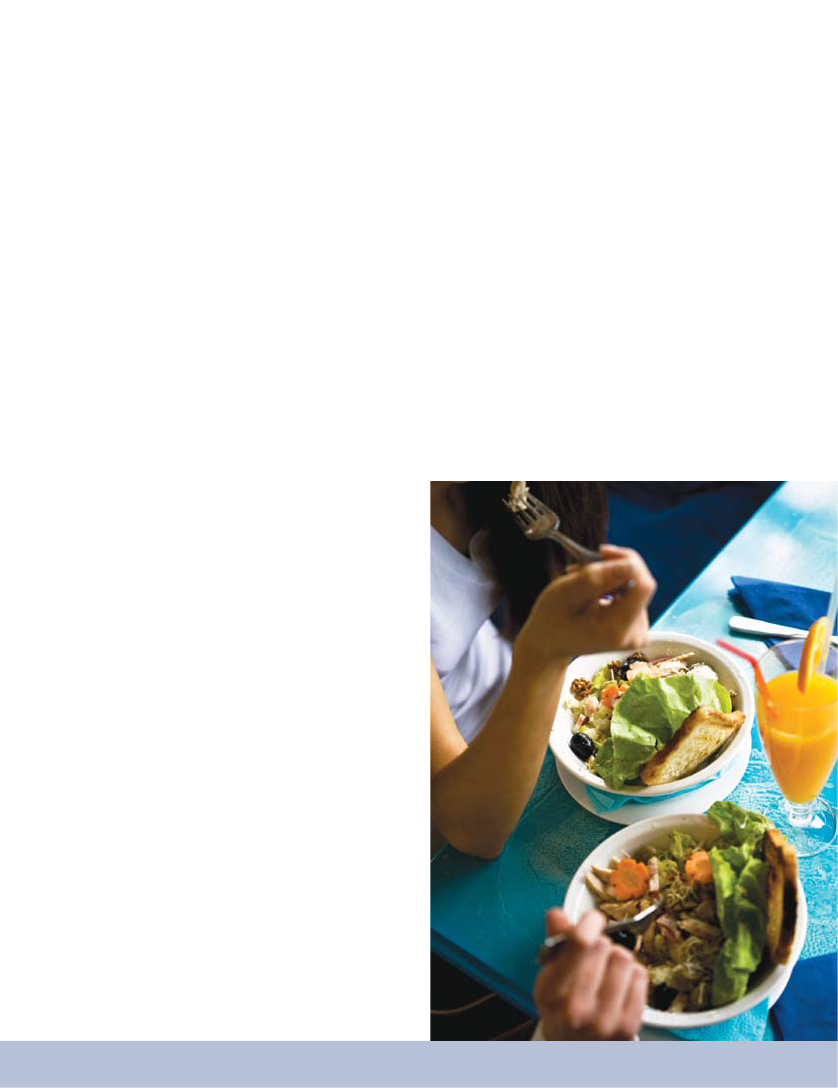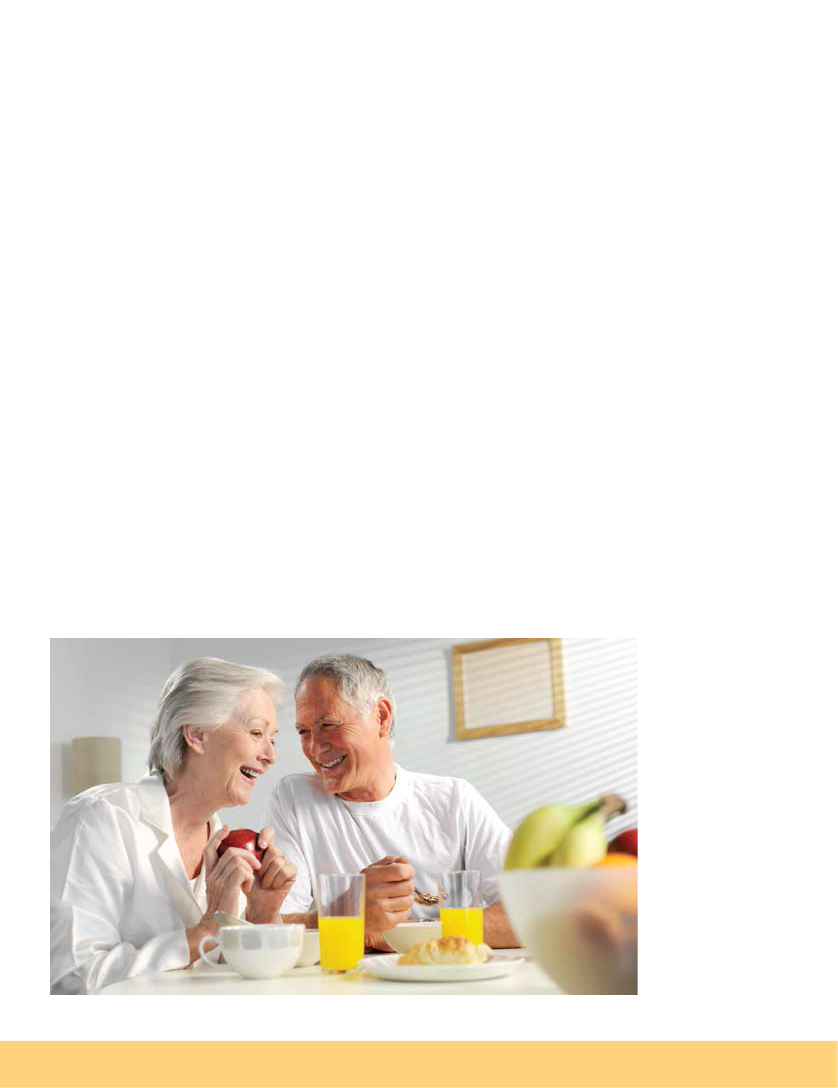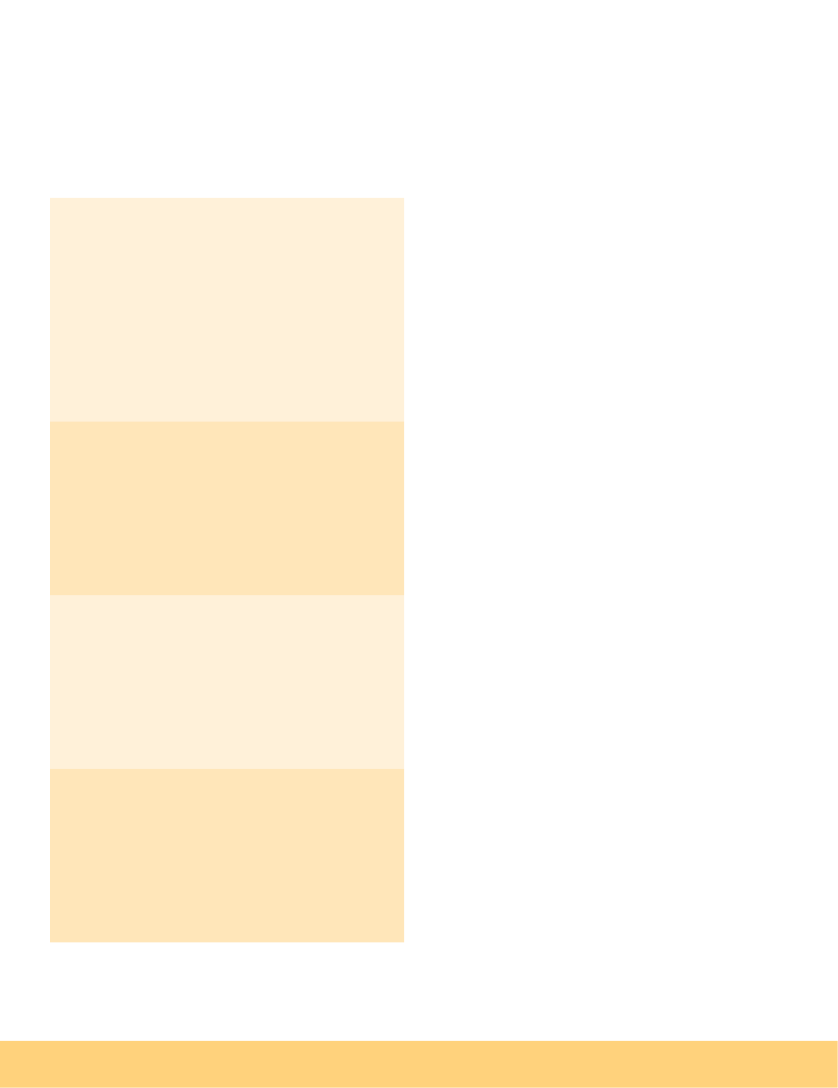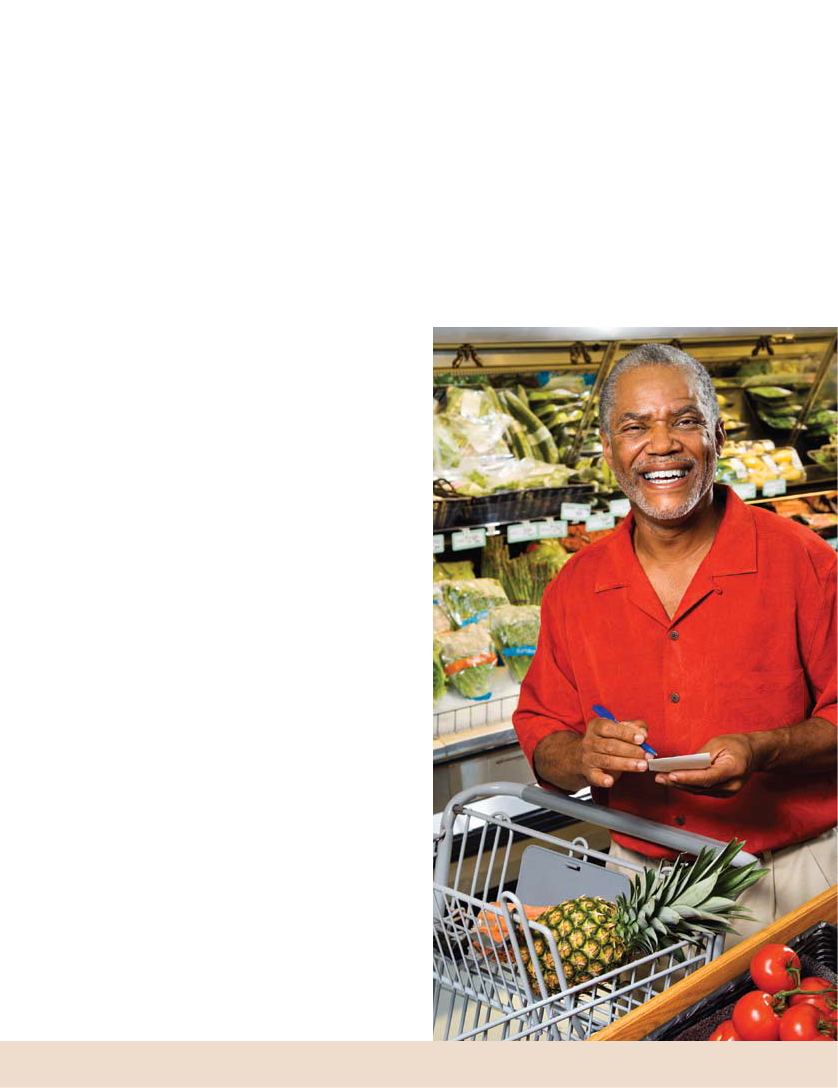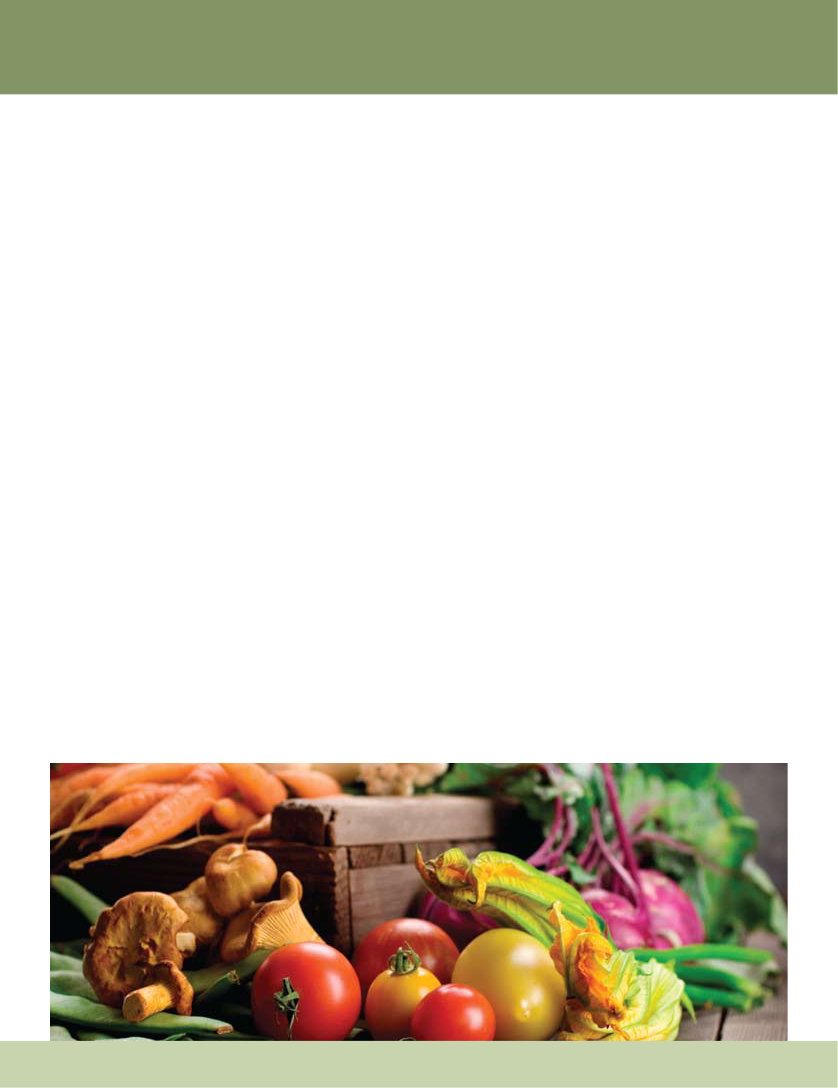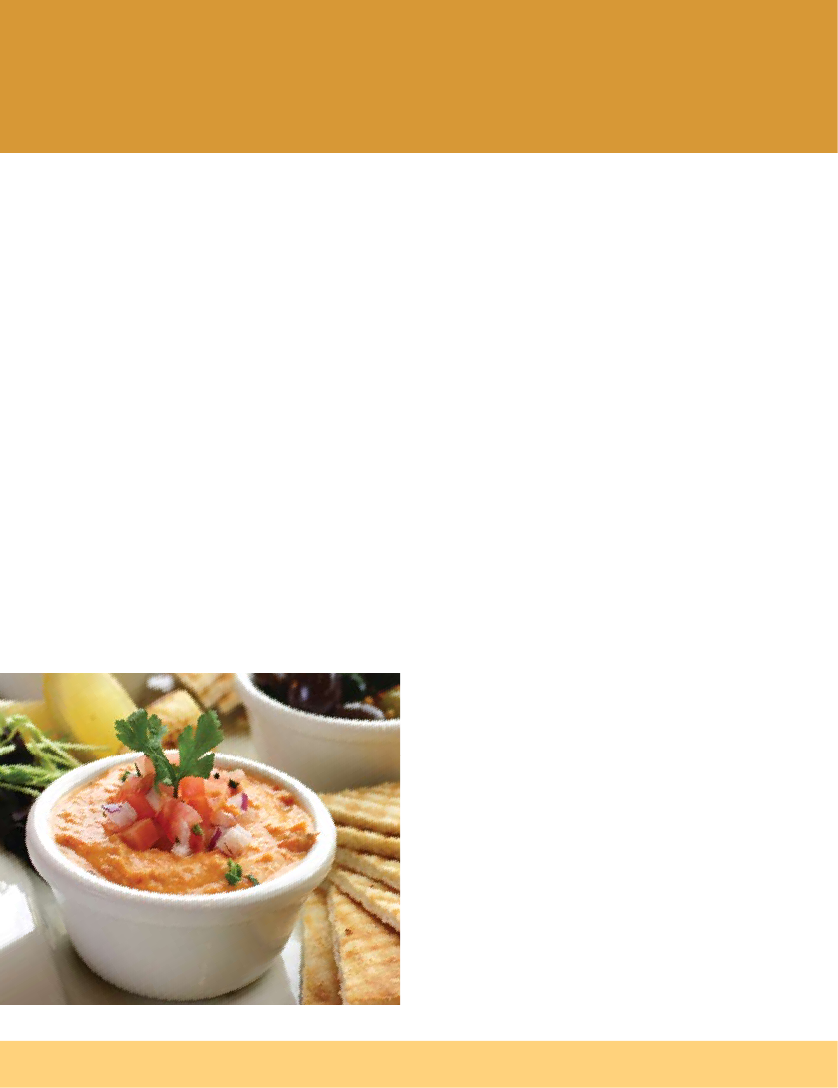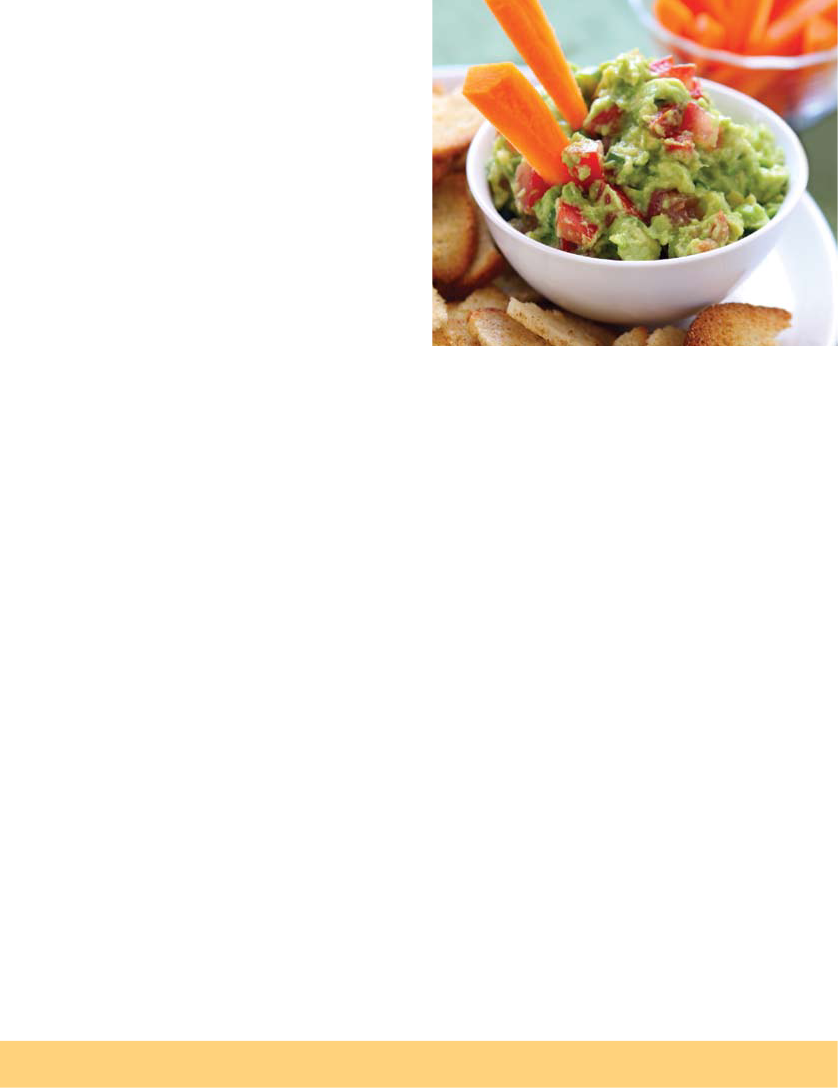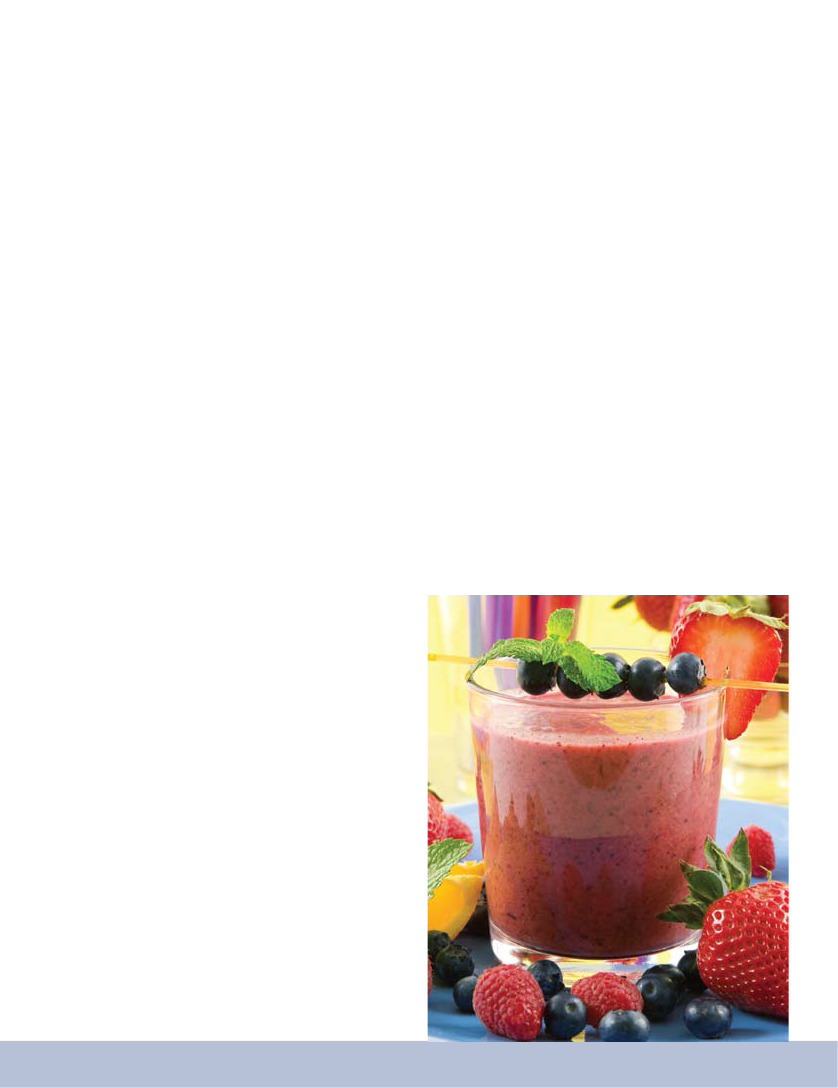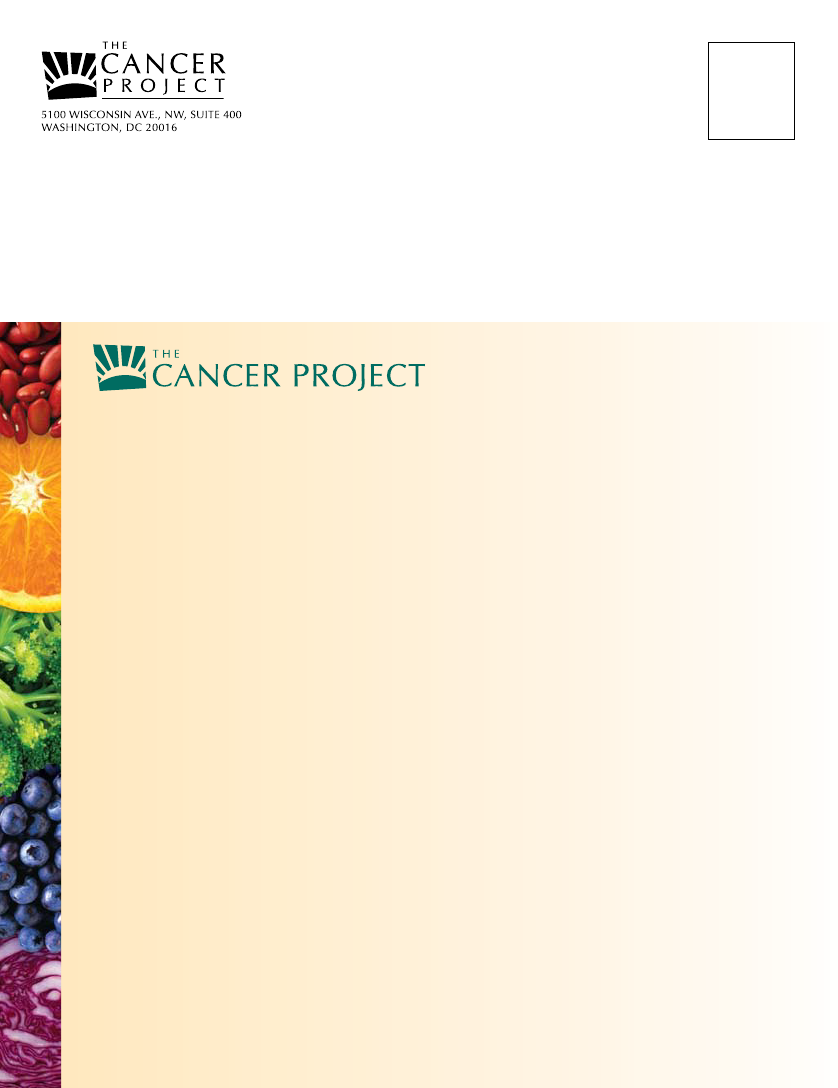Sundheds- og Forebyggelsesudvalget 2011-12
SUU Alm.del Bilag 245
Offentligt
Healthy EatingforLife
Food Choices for Cancer
Prevention and Survival
More than 1 million people are diagnosed with cancer in the United States each year, and thereis an urgent need for a new direction in battling this disease. That’s why physicians, researchers,nutritionists, and cancer specialists have joined together to form The Cancer Project.The Cancer Project has two main goals. First, we aim to make cancer prevention a top priority.Second, and just as important, we want to improve survival after cancer has been diagnosed byoffering comprehensive information about the role of dietary factors in keeping people healthy.The Cancer Project provides classes, books, television and video programs, Web-based informationatwww.CancerProject.org,brochures, and other educational materials on cancer prevention andsurvival. The Cancer Project also conducts clinical research studies to investigate dietary issuesand publicizes the need for cancer prevention in hard-hitting television messages spotlighting thevalue of healthy diet changes. Our hands-on nutrition classes, which help cancer survivors and theirfamilies learn new tastes and easy food preparation skills, have become incredibly popular. Throughregular media interviews, our staff members provide important information to the public aboutcancer prevention.Let me encourage you to support The Cancer Project. With your help, we’ll make cancer preventiona priority and help people diagnosed with cancer have the tools they need. Through our detailedand user-friendly Web site (www.CancerProject.org), printed materials, television public serviceannouncements, and hands-on services, we’re able to spread a life-saving message far and wide.Since the Cancer Project is a non-profit 501(c)(3) organization, all contributions are tax-deductibleto the full extent allowed by law.Thank you for your interest and support.Neal D. Barnard, M.D.
Physician, researcher, and author Neal D. Barnard is one of America’s leading ad-vocates for health, nutrition, and higher standards in research. Dr. Barnard is thefounder and president of the Physicians Committee for Responsible Medicine. Healso initiated The Cancer Project, an organization dedicated to cancer prevention,research, and nutritional assistance to cancer patients.
istockphoto
HEALTHY EATING FOR LIFE: FOOD CHOICES FOR CANCER PREVENTION AND SURVIVAL is pub-lished by The Cancer Project, 5100 Wisconsin Ave., NW, Suite 400, Washington, DC 20016, 202-244-5038,www.CancerProject.org.HEALTHY EATING FOR LIFE is not intended as individual medical advice. Always discuss any diet change withyour personal physician. In some cases, diet changes may alter your need for medication. Persons who follow a veg-etarian diet should be sure to include a source of vitamin B12in their daily routine, such as fortified cereals, fortifiedsoymilk, or any common multiple vitamin.Readers are welcome to reproduce articles from this publication for personal or educational use without addi-tional permission. Material should not be reproduced for resale without prior arrangement with The Cancer Project.� The Cancer Project, 2004.
Table of ContentsFood Choices for Cancer Preventionand Survival . . . . . . . . . . . . . . . . . . . . . . . . . . . . . . . . . . . . . . . . . . . . . . . . . . . . . . .p .4Building Your Strength Against CancerDefending Your DNA from Harm . . . . . . . . . . . . . . . . . . . . . . . . . . . . . . . . . . . .p .5Foods and Immunity . . . . . . . . . . . . . . . . . . . . . . . . . . . . . . . . . . . . . . . . . . . . . . . . .p .5Foods and Hormones . . . . . . . . . . . . . . . . . . . . . . . . . . . . . . . . . . . . . . . . . . . . . . . . .p .7Breast Cancer: Prevention . . . . . . . . . . . . . . . . . . . . . . . . . . . . . . . . . . . . . . . . . . .p .7Fat and Hormonal Effects . . . . . . . . . . . . . . . . . . . . . . . . . . . . . . . . . . . . . . . . . . .p .7How Much Fat Is Too Much? . . . . . . . . . . . . . . . . . . . . . . . . . . . . . . . . . . . . . . . .p .7Carcinogenic Compounds in Cooked Meat . . . . . . . . . . . . . . . . . . . . . . . . .p .8Cancers of the Uterus and Ovary: Prevention . . . . . . . . . . . . . . . . . . . . .p .9Prostate Cancer: Prevention . . . . . . . . . . . . . . . . . . . . . . . . . . . . . . . . . . . . . . . . .p .9Colon Cancer: Prevention . . . . . . . . . . . . . . . . . . . . . . . . . . . . . . . . . . . . . . . . . . .p .10Vegetarian Foods: Powerful for Health . . . . . . . . . . . . . . . . . . . . . . . . . . .p .10Try the New Four Food Groups . . . . . . . . . . . . . . . . . . . . . . . . . . . . . . . . . . . . .p .11Setting Blame Aside . . . . . . . . . . . . . . . . . . . . . . . . . . . . . . . . . . . . . . . . . . . . . . . . .p .11Steps to Cancer Prevention . . . . . . . . . . . . . . . . . . . . . . . . . . . . . . . . . . . . . . . . .p .11
Surviving CancerBreast Cancer: Survival . . . . . . . . . . . . . . . . . . . . . . . . . . . . . . . . . . . . . . . . . . . . . .p .11Cancers of the Uterus and Ovary: Survival . . . . . . . . . . . . . . . . . . . . . . .p .12Prostate Cancer: Survival . . . . . . . . . . . . . . . . . . . . . . . . . . . . . . . . . . . . . . . . . . .p .12Colon Cancer: Survival . . . . . . . . . . . . . . . . . . . . . . . . . . . . . . . . . . . . . . . . . . . . . . .p .13
Making Healthy Diet ChangesThe Three-Step Way to Go Vegetarian . . . . . . . . . . . . . . . . . . . . . . . . . . . . .p .13Tips for Making the Switch to a Vegetarian Diet . . . . . . . . . . . . . . . .p .14Affordable Eating . . . . . . . . . . . . . . . . . . . . . . . . . . . . . . . . . . . . . . . . . . . . . . . . . . . .p .14Top Five Foods You Can’t Live Without . . . . . . . . . . . . . . . . . . . . . . . . . . .p .14
References . . . . . . . . . . . . . . . . . . . . . . . . . . . . . . . . . . . . . . . . . . . . . . . . . . . . . . . .p .15Recipes . . . . . . . . . . . . . . . . . . . . . . . . . . . . . . . . . . . . . . . . . . . . . . . . . . . . . . . . . . . . .p .16The CanCer ProjeCT•healThy eaTing For liFe3
Food Choices for CancerPrevention and Survival
A
pproximately 80 percent of cancers are due to factorsthat have been identified and can potentially be con-trolled, according to the National Cancer Institute. Notonly do we have the potential to prevent most cancers, we canalso improve the survival rates of people who have cancer.
Cancer starts when one cell begins to multiply out of control. Itbegins to expand into a lump that can invade healthy tissues andspread to other parts of the body. But this deadly disease canoften be prevented, and when it occurs, it can often be stoppedin its tracks.At least one-third of annual cancer deaths in the United Statesare due to dietary factors.1A recent review of diet and cancershows that much of our risk for colon, breast, and prostatecancer, among other types, is due to dietary factors.2,3
The link between diet and cancer is not new. In January of1892, Scientific American printed the observation that “can-cer is most frequent among those branches of the human racewhere carnivorous habits prevail.” Numerous research studieshave since shown that cancer is much more common in popu-lations consuming diets rich in fatty foods, particularly meat,and much less common in countries with diets rich in grains,vegetables, and fruits. One reason is that foods affect the actionof hormones in the body. They also affect the strength of the im-mune system. While fruits and vegetables contain a variety ofvitamins, minerals, antioxidants, and phytochemicals that pro-tect the body, research shows that, by contrast, animal productscontain potentially carcinogenic compounds that may contrib-ute to increased cancer risk.
Established or SuspectedObesity-Related Cancers4Breast (postmenopausal)Prostate (advanced)PancreasEsophagus (adenocarcinoma)Gastric Cardia (adenocarcinoma)EndometriumColon and RectumLiverGallbladderKidney (renal cell)Non-Hodgkin’s LymphomaMultiple MyelomaLeukemiaStomach (men)OvaryUterusCervixAnother 30 percent of cancers are caused by tobacco. Lungcancer is the most obvious example, but it is by no means theonly one. Cancers of the mouth, throat, kidney, and bladder arealso caused by tobacco. Other factors, including physical activ-ity, reproductive and sexual behavior, bacterial and viral infec-tions, and exposure to radiation and chemicals, may also con-tribute to the risk of certain forms of cancer.
4The CanCer ProjeCT•healThy eaTing For liFe
istockphoto
Building Your StrengthAgainst CancerSome dietary changes have a preventive effect for many typesof cancer. Boosting your intake of vitamin-rich vegetables andfruits, for example, strengthens your immune system and helpsknock out cancer cells. To help prevent cancer, it is also smartto avoid meats, dairy products, and fried foods. Choosing fiber-rich legumes, grains, vegetables, and fruits helps keep manytypes of cancer at bay. Plant foods also contain a wide variety ofcancer-fighting substances called phytochemicals.These facts all point to choosing a vegetarian diet to help pre-vent cancer and improve cancer survival. Studies of vegetariansshow that death rates from cancer are only about one-half tothree-quarters of those of the general population. Breast can-cer rates are dramatically lower in countries such as China andJapan, where diets are typically based on rice, vegetables, andbean products, with very little use of meat, dairy products, oroily foods. When people from those countries adopt a Western,meat-based diet, their breast cancer rates soar.Are you ready to start enjoying the powerful benefits of a veg-etarian diet? See “The Three-Step Way to Go Vegetarian” onpage 13.
Defending Your DNA From HarmLet’s look at the steps we can take to build our general defenses.Oxygen is essential to life. But as oxygen is used in the body, someof the oxygen molecules become very unstable. These unstablemolecules, called free radicals, can attack cell membranes andeven damage the DNA (our genetic code) in the nucleus of thecell. Damage to DNA is the beginning of cancer.Fortunately, the foods we eat can help protect our bodies.Antioxidants, including vitamin C, vitamin E, beta-carotene,
is low in vitamin C has a one-in-four risk of dying of lung can-cer in the next 25 years. But if the smoker has a high intake ofvitamin C, either through diet or supplements, his risk drops to7 percent. Effects of antioxidants have even been seen in child-hood. When children with brain tumors were studied, it wasfound that their mothers consumed less vitamin C during preg-nancy, compared to other women.7To step up the antioxidant power of your menus, try a bakedsweet potato, Easy Bean Salad, or baked corn chips with ColorfulCorn Salsa (recipes on pages 17 and 18).Even with vegetables and fruits in the diet, damage to the cells’DNA will occasionally occur, so the body has built-in repairmachinery. Fixing damaged DNA, which could otherwise causecancer, requires a B vitamin called folic acid, which is found indark green leafy vegetables, fruits, peas, and beans. Recent evi-dence suggests that folic acid may be particularly important inpreventing HPV-related cervical cancer.8The Dietary Reference Intake for folic acid for adult womenand men is 400 micrograms per day and increases to 600 mi-crograms per day for pregnant women. Beans and vegetablesare rich in folic acid. Asparagus, black beans, black-eyed peas,chickpeas, lentils, pinto beans, and cooked spinach all havemore than 200 micrograms in a one-cup serving.We are all exposed to cancer-causing chemicals despite our ef-forts to avoid them. Some people are smokers, and, of course,quitting smoking is a vital step for them. But all of us are ex-posed to chemicals in the air, water, food, and household prod-ucts in addition to the carcinogens produced within our bodiesas a part of our metabolic processes. While trying to minimizeour exposure to carcinogens, we can also shore up our defensesagainst these assaults by including generous amounts of vegeta-bles and fruits in our diet.
Foods and ImmunityEven if we follow healthy lifestyles, cancer cells will arise inthe body from time to time. Luckily, we have white blood cellsthat roam our bloodstreams looking for these troublemakers.Some white blood cells, called natural killer cells, seek out anddestroy cancer cells and bacteria. They engulf and destroy aber-rant cells before they can cause damage. The function of naturalkiller cells and other white blood cells is improved by as littleas 30 milligrams of beta-carotene per day—the amount in twolarge carrots.Although beta-carotene is safe, even in fairly substantialamounts, the best way to get beta-carotene is not in pills, butin carrots, winter squash, spinach, kale, and the other packagesin which nature supplies it. Beta-carotene is only one of per-haps two dozen related substances called carotenoids that occurnaturally in vegetables and fruits and have varying degrees ofbiological activity.In a recent research review, cancer experts found signifi-cant evidence suggesting that carotenoids help protect againstesophageal, lung, and mouth cancers.3In addition to their antioxidant effects, vitamins C and E and
Estimated Percentages of CancerDue to Selected Factors5,6DietTobaccoAir and water pollutionAlcoholRadiationMedications35 to 60%30%5%3%3%2%
selenium, lycopene, and others, can neutralize the damagingeffects of oxygen. These powerful natural chemicals come tous in vegetables, fruits, grains, and beans. People who includefruits and vegetables in their daily diets have lower rates of manyforms of cancer.Smokers have provided dramatic demonstrations of the powerof vegetables and fruits. A 55-year-old male smoker whose diet
The CanCer ProjeCT•healThy eaTing For liFe5
Antioxidants in FoodsApple (1 medium)BroccoliBrown riceBrussels sproutsCarrot (1 medium)CauliflowerChickpeasCornGrapefruit (pink, 1/2)Navy beansOrange (1 medium)Orange juicePineappleSoybeansFresh spinachStrawberriesSweet potato(1 medium with skin)
9,10,11
Vit C(mg)811609675421047275124243168428
B-carotene(mg)0.041.300.000.6712.000.010.020.220.190.000.160.300.020.012.300.0215.00
Vit E(mg)0.441.324.001.330.280.050.570.150.314.100.310.220.163.350.570.230.32
Serving sizes are one cup (8 oz.), except as otherwise noted.
selenium bolster immune function, but the importance ofthese effects in protecting against cancer is not yet clear.Fats impair immunity, and cutting fat out of the diet helpsstrengthen the immune defenses against cells that turn can-cerous. Researchers in New York tested the effect of low-fatdiets on immunity.12They put healthy volunteers on a dietthat limited fat content to 20 percent, reducing all fats andoils—not just saturated or unsaturated fats. Three monthslater, the researchers took blood samples from the volunteersand examined their natural killer cells. The natural killer cellactivity was greatly improved.Although vegetable oils are far superior to animal fats forheart patients, when it comes to the immune system, vege-table oils are no better than animal fats. In experiments, re-searchers have found that when they infuse soybean oil intra-venously into volunteers, the white blood cells no longer workas well.13Test tube experiments show similar results.Similarly, omega3 fatty acids, which are found in fish oils,green vegetables, and soybean, flax seed, and canola oils, alsocompromise immune function. The bottom line on fats andoils: greatly reduce your intake of all of them.It should come as no surprise that vegetarians have stron-ger immune systems than meat-eaters. Studies of white bloodcell samples from vegetarians have shown them to have morethan double the cancer cell-destroying ability of their non-vegetarian counterparts.15The immune-boosting power ofvegetarian diets is partly due to their vitamin content, low fatcontent, and perhaps other contributors, such as reduced ex-posure to toxic chemicals and animal proteins.Dietary fat intake can also contribute to weight gain, whichcan impair immune function. Studies show that overweightindividuals are at increased susceptibility to various infec-tions and to certain forms of cancer, especially postmeno-pausal breast cancer.16
Cutting fatout of thediet helpsstrengthenthe immunedefensesagainst cellsthat turnistockphoto
cancerous.6The CanCer ProjeCT•healThy eaTing For liFe
Foods and HormonesSeveral of the most common forms of cancer are linked to sexhormones. This is true of cancers of the breast, uterus, ovary,prostate, and perhaps other sites. The amount of hormones inour bodies and their actions are determined, in large part, bythe foods we eat.
Breast Cancer: PreventionAs long ago as 1982, the National Research Council in a re-port called “Diet, Nutrition, and Cancer,” showed the evidencealready available linking specific dietary factors to cancer of thebreast and other organs.International comparisons offer a good illustration. Asiancountries, such as Japan, have low rates of breast cancer, whileWestern countries have cancer rates many times higher. How-ever, when Japanese girls are raised on Westernized diets, theirrates of breast cancer increase dramatically.The traditional Japanese diet is much lower in fat, especiallyanimal fat, than the typical Western diet. In the late 1940s, whenbreast cancer was particularly rare in that country, less than 10percent of the calories in the Japanese diet came from fat. TheAmerican diet, of course, is centered on animal products, whichtend to be high in fat and low in other important nutrients. Thefat content of the average American diet is well above 30 percentof calories.It has long been known that countries with a higher intake offat, especially animal fat, have a higher incidence of breast can-cer. Even within Japan, affluent women who eat meat daily havean 8.5 times higher risk of breast cancer than poorer womenwho rarely or never eat meat. Two decades ago, the SurgeonGeneral’s “Report on Nutrition and Health” stated, “Indeed, acomparison of populations indicates that death rates for cancersof the breast, colon, and prostate are directly proportional toestimated dietary fat intakes.”
Animal fats are apparently a bigger problem than vegetableoils. Paolo Toniolo of the New York University Cancer Insti-tute compared the diets of 250 women with breast cancer to 499women without cancer from the same province in northwesternItaly. The two groups ate about the same amount of olive oil andcarbohydrates. What distinguished the cancer patients was thatthey had eaten more meat, cheese, butter, and milk. Women whoconsumed more animal products had as much as three times thecancer risk of other women.17A 2003 Harvard University study that included more than90,000 women showed that the women who had eaten the mostanimal fat had significantly higher risk of breast cancer com-pared with women who ate the least.18Even though cross-cultural comparisons have pointed a fingerat animal fat as the principal problem, vegetable oil is also un-der some suspicion. Vegetable oils can probably affect estrogenlevels and, as we will see, can increase the production of cancer-causing free radicals. So it is no good just replacing fried chickenwith fried onion rings. The best diet eliminates animal productsand keeps vegetable oils to a minimum as well.Certain foods have special benefits. Soybeans, for example,contain natural compounds called phytoestrogens. These arevery weak estrogens that can occupy the estrogen receptors onbreast cells, displacing normal estrogens. The result is less estro-gen stimulation of each cell. Soybeans are a mainstay of Asiandiets and may be an additional reason why these countries havelow cancer rates.
How Much Fat Is Too Much?The National Cancer Institute has long recommended that fatbe limited to less than 30 percent of calories and that the fattiestmeats be replaced by leaner meat, poultry, fish, and vegetables.These recommendations, however, are much too weak to preventcancer or to increase survival for those already diagnosed withthe disease. A large study of American nurses showed that thosewho limited fat to 27 percent of their calories were not any bet-ter off in preventing cancer than those consuming more fat.19Some have interpreted this to mean that diet has nothing to dowith breast cancer. A more reasonable conclusion is that the dietsthese women followed were still high-risk diets. After all, a dietincluding regular consumption of animal products and drawingnearly 30 percent of calories from fat is nothing like the tradi-tional plant-based Asian diets associated with low cancer risk.
Fat and Hormonal EffectsFatty foods have a strong influence on hormonal activity in thebody. First, high-fat diets increase the amount of estrogens, thefemale sex hormones, in the blood. This is a problem, becauseit is well known that many breast tumors are “fueled” by es-trogens. Estrogens are normal and essential hormones for bothwomen and men, but the more estrogen present, the greater thedriving force behind some kinds of breast cancer. On high-fatdiets, estrogen levels increase. When women adopt low-fat diets,their estrogen levels drop noticeably in a very short time. Veg-etarians have significantly lower estrogen levels than non-vege-tarians, in part because of the lower fat content of their diet. Inaddition, they have more of certain carrier molecules, called sexhormone–binding globulin, that circulate in the blood and havethe job of holding onto sex hormones, keeping them inactiveuntil they are needed. Fatty foods do the reverse: they increaseestrogens and reduce the amount of the carrier molecule that issupposed to keep estrogens in check.
Favoring FiberGrains, vegetables, fruits, and legumes ensure plenty of fiber,but chicken breasts, beef, pork, eggs, cheese, and all other ani-mal products contain no fiber at all.Getting the fat off your plate is important—but that is just thefirst step. Other food choices play important roles in cancerprevention. Vegetables, fruits, grains, and beans provide fiber,which helps the body dispose of excess estrogen.One way the body rids itself of sex hormones is through thedigestive tract. The liver pulls sex hormones from the blood,chemically alters them, and sends them down the bile ducts into
The CanCer ProjeCT•healThy eaTing For liFe7
the intestinal tract. There, the fiber from grains, vegetables,fruits, and beans ushers sex hormones through the intestineand out the door as wastes. At least, that is how the systemis supposed to work. But chicken breasts, beef, eggs, cheese,and all other animal products contain no fiber at all. As theseproducts have taken up more and more space on the Ameri-can plate, they have displaced grains, vegetables, beans, andfruits. Without adequate fiber to hold them in the digestivetract, sex hormones are reabsorbed into the bloodstream,where they once again become biologically active. The hor-mones your body was trying to eliminate are thus put backinto circulation.Building your diet from grains, vegetables, fruits, and le-gumes ensures plenty of fiber for the body’s needs. To increaseyour daily fiber intake, start your day with oatmeal and fruit,and try adding delicious, low-fat, fiber-rich recipes such asThree-Bean Chili or Easy Bean Salad to your weekly menu(see recipes on page 18).
exposure to PAHs may play a role in the development ofstomach cancer in humans.
Other FactorsAside from diet, other factors increase breast cancer risk,including the following:Hormones:Supplemental hormones given to women aftermenopause increase breast cancer risk. Oral contraceptivesmay also increase risk slightly. Although newer birth-controlpills contain less estrogen and progesterone than older ver-sions, evidence suggests some increase in risk.Overweight:Higher body weight increases the risk of breastcancer after menopause.Radiation:Of all the different parts of the body, the breast isprobably the most sensitive to X-ray damage, and there is nodoubt that X-rays to the breast can cause cancer.This raises obvious concerns about mammograms, which,after all, are X-rays. Annual mammograms are clearly ben-eficial for women over 50. But women should schedule mam-mograms only at modern facilities that do them regularly andmaintain new equipment, which keeps radiation doses to aminimum. For women under 50, it is unclear whether rou-tine mammograms are beneficial. Many cancers are missedon mammograms, and women have sometimes been falselyreassured by a negative mammogram, leading to delays in di-agnosis and treatment. All women (especially those under 50)should do regular self-exams and follow their physicians’ rec-ommendations regarding mammogram screening.Genetics:About 5 percent of breast cancer cases are purelyattributable to genetics. In such cases, cancer is passed fromparent to child as a dominant trait, and the family tree isriddled with the disease. For a larger group of individuals,genetics probably makes a contribution in subtle ways. Forexample, it may well be that different genes influence one’ssusceptibility to carcinogens, the strength of the immunesystem, body weight, and other factors. Each of these is alsoinfluenced by diet.Toxic Chemicals:Populations in areas near toxic waste sitestend to have higher than average rates of breast cancer. Thatis true for other forms of cancer, too. And you don’t have tolive near a chemical waste site to be concerned about toxicexposures. Toxic chemicals are available at any grocery store.Chemical contaminants frequently end up in meats and dairyproducts, because pesticides are sprayed on grains fed to cows,chickens, pigs, and other livestock. In storage bins, feed grainsare sprayed again. Animals concentrate these chemicals intheir tissues. Traces of pesticides can also be found on non-organic produce. Fortunately, organic produce is now morewidely available.Women who avoid eating animal products have much lowerconcentrations of pesticides in their breast milk. Pesticidessuch as DDT, chlordane, hepatochlor, and dieldrin, and poly-chlorinated biphenyls (PCBs) have been measured at mark-edly lower levels in vegetarians than in omnivores. In a 1981
Carcinogenic Compounds in Cooked MeatNot only is meat devoid of fiber and other nutrients thathave a protective effect, but it also contains animal protein,saturated fat, and, in some cases, carcinogenic compoundsformed during the process of cooking meat. These carcino-genic compounds may be to blame for part of the correlationbetween meat intake and increased cancer risk. Meat intakehas been shown to be a risk factor for breast cancer even whenresearchers controlled for confounding factors such as totalfat and calorie intake.20
Heterocyclic AminesHeterocyclic amines (HCAs) are DNA-damaging com-pounds that are produced as meat cooks. Grilling, frying, oroven-broiling meat produces large quantities of these mu-tagens. The longer and hotter the meat is cooked, the moreof these compounds form. In some studies, grilled chickenformed higher concentrations of these cancer-causing sub-stances than other types of cooked meat.21The major classes of HCAs are formed from creatine or crea-tinine, specific amino acids, and sugars. All meats, includingfish, are high in creatine. HCA formation is greatest whenmeat is cooked at high temperatures, as is most common withgrilling or frying. Consumption of well-done meat has beenassociated with increased risk of breast cancer and colon can-cer.
Polycyclic Aromatic HydrocarbonsGrilling or broiling meat over a direct flame results infat dropping on the hot fire and the production of flamescontaining polycyclic aromatic hydrocarbon (PAH). PAHsadhere to the surface of food; the more intense the heat, themore PAHs are present. They are believed to play a significantrole in contributing to human cancers. A fairly consistentassociation between grilled or broiled, but not fried, meatconsumption and stomach cancer implies that dietary
8The CanCer ProjeCT•healThy eaTing For liFe
istockphoto
study, vegetarians had only 1 to 2 percent of the national averagelevels of certain pesticides and industrial chemicals comparedto levels in average Americans.22The exception was polychlori-nated biphenyls (PCBs), for which vegetarians had levels compa-rable to meat-eaters. PCBs in the body often reflect past fish con-sumption, and levels drop slowly after people adopt a vegetariandiet. Once PCBs are in the body tissues, avoiding contaminatedfish will reduce PCB levels only very slowly.Time between Puberty and First Pregnancy:The younger agirl is when puberty occurs, the higher her risk of breast can-cer. Also, the later the age of her first pregnancy, the higher herrisk. However, it may be that the early age of puberty simplyindicates elevated hormone levels, as described above. As high-fat, low-fiber diets have spread from the wealthy to most of thepopulation, the age of puberty has dropped dramatically from17 in 1840 to 12.5 today. Similarly, as Japan’s diet has Western-ized since World War II, the age of puberty has dropped from15 to 12.5. It may be that early puberty and cancer are both theresult of a hormonal aberration.
Cancers 0f the Uterus and Ovary: PreventionThe uterus and ovary, of course, are reproductive organs, andfactors that affect hormone function can be expected to affectthese organs as well. The risk of cancer of the uterus and ovaryis higher in populations that have more breast cancer incidences,suggesting that they may be caused by similar factors. Uterinecancer is linked to fatty diets and obesity, although other factors,including hormone supplements, also play an important role.23Some researchers have suggested that a higher intake of dairyproducts may be linked to ovarian cancer. If this finding holdstrue, the culprit may be a product of the breakdown of the milksugar lactose. Lactose breaks down in the body to form anothersugar called galactose, which appears to be able to damage theovary. The problem is the milk sugar, not the milk fat, so it is notsolved by using non-fat products. Further research in this areais needed.
some point in his life.Asian and Latin American countries have a much lower prev-alence of prostate cancer, but the disease is very common inEurope and North America. Ten men die of prostate cancer inWestern Europe for every one who dies of the disease in Asia.Cancer of the prostate is strongly linked to what men eat.Again, animal products are frequently indicted: milk, meat,eggs, cheese, cream, butter, and fats are found, in one researchstudy after another, to be linked to prostate cancer.24And it is not just dairy products and meats. Some studies havealso pointed a finger at vegetable oils.25,26More recently, milkconsumption has been linked to prostate cancer due to high lev-els of the compound insulin-like growth factor (IGF-I), which isfound both in dairy products and in increased levels in the bod-ies of those who consume dairy on a regular basis. A HarvardUniversity study showed that men who had the highest levelsof IGF-I had more than four times the risk of prostate cancercompared with those who had the lowest levels.27In addition,two major Harvard studies have shown that milk-drinking menhave 30 to 60 percent greater prostate cancer risk than men whogenerally avoid dairy products.28,29Who has a lower risk? Countries with more rice, soybeanproducts, or green or yellow vegetables in the diet have far fewerprostate cancer deaths. Diets rich in lycopene, the bright red
Prostate Cancer: PreventionLike women, men on high-fat Western diets have more estro-gens circulating in their blood and a higher risk of cancer of re-productive organs. High-fat diets alter the amounts of testoster-one, estrogen, and other hormones in both men and women.The prostate gland, located just below the bladder in men, pro-duces semen to be mixed with sperm cells. Cancer of the pros-tate, which occurs primarily in older individuals, is the mostcommon form of cancer in American men.Cancer cells are found in the prostates of about 20 percent ofmen over 45 years old. In most cases, these cancer cells do notdevelop into cancerous tumors that affect the overall health orlife span of the individual. However, in some cases, the cancerdoes grow, invade surrounding tissues, and spread to otherparts of the body. Although the disease varies greatly from oneperson to the next, the average patient loses nine years from hisnormal life span. One in 10 men will develop prostate cancer at
The CanCer ProjeCT•healThy eaTing For liFe9
pigment found in tomatoes, watermelon, and pink grapefruit,have also been shown to prevent prostate cancer. A study at Har-vard University showed that men who had just two servings oftomato sauce per week had a 23 percent lower risk of prostatecancer, compared with those who rarely ate tomato products.30It is not surprising that vegetarians have low rates of prostatecancer. Becoming a vegetarian in adulthood is helpful, but menraised as vegetarians have the lowest risk.Men who consume diets based on animal products tend tohave higher levels of testosterone compared with men who eatplant-based diets. This increase may be due to overproduction ofthese hormones in the body. Also, fiber in the diet helps removeexcess hormones with body wastes. Those who eat meats anddairy products miss out on a substantial amount of fiber, be-cause animal products have no fiber at all. This hormonal boostcan affect the prostate, which is the likely reason for increasedcancer risk among men on meat-based diets.
Colon Cancer: PreventionThe colon is another name for the large intestine, which makesup the second half of our digestive tract. Strong links have beenfound between colon cancer and the consumption of alcohol,meat, and other fatty foods.3To absorb the fats we eat, our liver makes bile and stores it inthe gallbladder. After a meal, the gallbladder squirts bile acidsinto the intestine, where the acids chemically modify the fats sothey can be absorbed. Unfortunately, bacteria in the intestineturn these bile acids into cancer-promoting substances calledsecondary bile acids. Meats contain a substantial amount of fat,and they also foster the growth of bacteria that cause carcino-genic secondary bile acids to form. When meat is cooked, car-cinogens can form on the surface of the food. As with breast
cancer, frequent consumption of meat—particularly red meat—is associated with an increased risk of colon cancer.31High-fiber diets offer a measure of protection. Fiber greatlyspeeds the passage of food through the colon, effectively remov-ing carcinogens. And fiber actually changes the type of bacteriapresent in the intestine, which reduces production of carcino-genic secondary bile acids. Fiber also absorbs and dilutes bileacids.Even people at particular risk for cancer can be helped by high-fiber diets. Jerome J. DeCosse, M.D., a surgeon at Cornell MedicalCenter, gave bran to patients with recurrent polyps of the colon.These are small growths that have a tendency to become can-cerous. Dr. DeCosse found that, within six months, the polypsbecame smaller and fewer in number. He believes that pentosefiber, which is plentiful in wheat, is the key to bran’s power.32Obesity may also influence cancer risk. In a recent study, 1,252women were screened for colon cancer and classified accord-ing to age, smoking history, family history of colorectal cancer,and body mass index or BMI. BMI was found to be the greatestrisk factor for colon cancer.33Fiber is also important for helpingmaintain a healthy body weight.
Vegetarian Foods: Powerful for HealthTwo themes consistently emerge from cancer research: Veg-etables and fruits help reduce risk, while animal products andother fatty foods are frequently found to increase risk.When the terms “fiber” and “fat” are used, it is easy to forgetthe foods from which they come. When you hear about the dan-gers of fat, think meat- and- dairy-based diets, aided and abettedby oily foods. Fiber is found in whole grains, vegetables, fruits,and beans. There is no fiber in any product from an animal.
even peopleat particularrisk forcancer canbe helpedby high-fiber diets.istockphoto
10The CanCer ProjeCT•healThy eaTing For liFe
A vegetarian menu is a powerful and pleasurable way to achievegood health. The vegetarian eating pattern is based on a widevariety of foods that are satisfying, delicious, and healthful. Areyou ready to get started?
Setting Blame AsideOccasionally people who have cancer report feeling that, iffood plays a role in cancer, then they are somehow to blame fortheir disease. As such, guilt and blame often become concernsfor people dealing with cancer. However, these feelings are bur-dens that help no one. Besides, it makes no sense to blame any-one for things they had no way of knowing. Until major publiceducation programs spread the word about the role of dietaryfactors and help people to change, cancer will remain an epi-demic.
Try the New Four Food Groupsand Discover a Healthier Way To Live!Vegetables (4 or more servings a day)Vegetables are packed with nutrients, including vitaminC, beta-carotene, riboflavin, iron, calcium, fiber, and oth-er nutrients. Dark-green leafy vegetables, such as broccoli,collards, kale, mustard and turnip greens, chicory, andbok choy, are especially good sources of these importantnutrients. Dark-yellow and orange vegetables such as car-rots, winter squash, sweet potatoes, and pumpkin provideextra beta-carotene. Include generous portions of a vari-ety of vegetables in your diet.
Steps to Cancer Prevention• Do not use tobacco in any form.• Eat a varied menu (whole grains, vegetables, fruits, and beans, without added fats), which supplies generous amounts of fi-ber, vitamins, and minerals and derives less than 10 percentof its calories from fat.• Have more than one vegetable at each meal and five to nine fruits and vegetables each day.• Consume at least 40 grams of fiber per day.• Avoid animal products and minimize added vegetable oils.• Minimize alcohol intake.• Engage in regular physical activity.• Maintain your weight at or near your ideal level.• Avoid excessive sunlight and unnecessary X-rays.• Be sure to take a daily multiple vitamin or other reliable source of vitamin B12.
Serving size: 1 cup raw vegetables • 1/2 cup cooked vegetables
Whole Grains (5 or more servings a day)This group includes bread, rice, pasta, hot or cold cereal,corn, millet, barley, bulgur, buckwheat groats, and torti-llas. Build each of your meals around a hearty grain dish.Grains are rich in fiber and other complex carbohydrates,as well as protein, B vitamins, and zinc.
Serving size: 1/2 cup hot cereal • 1 ounce dry cereal1 slice bread
Fruit (3 or more servings a day)Fruits are rich in fiber, vitamin C, and beta-carotene. Besure to include at least one serving each day of fruits highin vitamin C—citrus fruits, melons, and strawberriesare all good choices. Choose whole fruit over fruit juices,which do not contain very much fiber.
Surviving CancerFoods are important, not only in preventing cancer, but also inimproving survival for those who already have cancer.
Breast Cancer: SurvivalNot all cancers of the breast are the same. Some have a rela-tively good prognosis, and others have a very poor prognosis.For example, a tumor that is small and has not spread to thelymph nodes or other organs is less dangerous than a tumor thatis larger and has already spread. (Lymph nodes are pea-sizedcollections of cells near the breast and other organs; they areimportant to immune function.) Hospital laboratories also de-termine whether a breast tumor has receptors for estrogen orprogesterone hormones. If it does, the tumor is slightly less ag-gressive than a tumor lacking receptors.These prognostic factors are not due to chance alone. Thirtyyears ago, Ernst Wynder of the American Health Foundationin New York observed that Japanese women are much less likelythan American women to get breast cancer; in addition, whenJapanese women do get the disease, they tend to survive lon-ger.34Their improved survival is independent of age, tumor size,estrogen receptor status, the extent of spread to lymph nodes,
Serving size: 1 medium piece of fruit • 1/2 cup cooked fruit4 ounces juice
Legumes (2 or more servings a day)Legumes, including beans, peas, and lentils, are all goodsources of fiber, protein, iron, calcium, zinc, and B vita-mins. This group also includes chickpeas, baked and re-fried beans, soymilk, tempeh, and texturized vegetableprotein.
Serving size: 1/2 cup cooked beans • 4 ounces tofu or tempeh8 ounces soymilkBe sure to include a good source of vitamin B12, such as fortifiedcereals or vitamin supplements.
The CanCer ProjeCT•healThy eaTing For liFe11
and the microscopic appearance of the cancer cells. And itis not that Japanese women have better health care, becausethe same pattern has been observed in Hawaii and California,where Japanese women live near other ethnic groups and haveessentially the same health-care system.Researchers have begun to look at whether diet plays a rolein survival. It does. Our old enemy, fat in foods, rears its uglyhead once again—the more fat in the diet, the shorter the sur-vival time. In one Canadian research study, women with can-cer were more likely to have lymph node involvement if theyhad a higher fat intake. This effect was found only for saturatedfat and only for postmenopausal women.35Fat seems to have ameasurable effect when cancer has spread to other parts of thebody and little or no effect when the disease is localized.Researchers in Buffalo, New York, calculated what they be-lieve to be the degree of risk posed by fat in the diet: For awoman with metastatic breast cancer (cancer that has alreadyspread at the time of diagnosis), the risk of dying from the dis-ease at any point increases 40 percent for every 1,000 gramsof fat consumed monthly.36To understand what this means,compare three different diets, each of which contains 1,800calories per day:• On a low-fat vegetarian diet, about 10 percent of calories come from fat. This type of diet contributes about 20 gramsof fat per day, or 600 grams per month.• On a typical American diet, 35 percent of calories come from fat. This means about 70 grams of fat per day, or 2,100grams per month.• On a diet with more fat than average, say 50 percent of calo-ries, fat intake would be 100 grams per day, or 3,000 gramsper month.If the researchers’ finding holds, the typical American dietwould lead to about a 60 percent higher risk of dying of breastcancer at any given point, compared to the low-fat vegetariandiet, and the high-fat diet would lead to a more than 95 per-cent increase in risk of dying. These figures do not mean thata woman’s risk of dying is 60 percent or 95 percent. They meanthat the risk is 60 percent or 95 percent higher than it wouldotherwise have been, assuming the individual is comparableto those studied.The Women’s Intervention Study (WINS) evaluated dietaryfat intake breast cancer recurrence in postmenopausal womenpreviously treated for breast cancer. A total of 2,437 womenwere enrolled in the study and were assigned either to a low-fatdiet (20 percent energy from fat), or to a control group with nodiet changes. After a 5-year follow-up, participants who hadpreviously been treated for estrogen-receptor-negative breastcancer, and who then reduced their fat intake to 33 gramsdaily, had a 42 percent reduced risk in breast cancer recur-rence compared with women who did not change their diets.Women who had been previously treated for estrogen-recep-tor-positive breast cancer and who then changed their dietshad a 15 percent reduced risk for breast cancer recurrencecompared with women who did not change their diets.37
Other parts of the diet play important roles. Diets high infiber, carbohydrate, and vitamin A seem to help the progno-sis, while alcohol slightly worsens it.38Patients who have moreestrogen receptors on their tumors—(which indicates a betterprognosis)—tend to be those who had consumed more vita-min A. (Beta-carotene becomes vitamin A in the body.) Forreasons that are not entirely clear, vegetables and fruits (andthe vitamins they contain) help keep the cells of the body inbetter working order—one sign of which, for breast cells, isthe presence of estrogen receptors. So vegetables and fruitsare not only important in helping to prevent cancer, they alsohelp improve survival for those who have cancer.Higher body weight increases the risk of dying of breastcancer.39Among postmenopausal women with breast cancer,slimmer women tend to have less lymph node involvement.Heavier women have more lymph node involvement, higherrates of recurrence, and poorer survival rates. Even amongrelatively slim women, it pays to avoid extra weight. A 2006study from Shanghai, China, showed that women who hadpreviously been diagnosed with breast cancer had greatersurvival rates if they were at the slimmer part of the normalweight range (body mass index below 23), compared witheven slightly heavier women.40
Cancers of the Uterus and Ovary: SurvivalThe uterus and ovary, like the breast, are strongly influencedby sex hormones. Again, a low-fat vegetarian diet is the bestprescription for preventing the hormonal elevations that en-courage cancer. In addition, as mentioned earlier, galactose—a product of the breakdown of the milk sugar lactose—mayincrease the risk of ovarian cancer.One might assume that the factors that improve breast can-cer survival could do the same for cancers of the uterus andovary. Unfortunately, researchers have not yet tackled this is-sue. Until more information is available, it seems most pru-dent for those with ovarian or uterine cancer to follow thesame diet that helps prevent cancer in these organs and thatkeeps the immune system in good working order: a low-fatvegetarian diet rich in vegetables and fruits.Maintaining a healthy weight and following a low-fat veg-etarian diet is the best prescription for preventing the hor-monal elevations that encourage cancer.41,42
Prostate Cancer: SurvivalDiet may help improve survival in prostate cancer as well.When pathologists conduct autopsies of men who die fromaccidents or other causes, they find cancer cells in the pros-tates of about 20 percent. These men did not know they hadcancer and had no symptoms whatsoever. The prevalence ofsuch latent cancers actually varies with location: the lowestrates are in Singapore (13 percent) and Hong Kong (15 per-cent) and the highest are in Sweden (31 percent).43In mostmen, the cells never grow into a large tumor, never spread,and never affect life or health in any way. However, just as the
12The CanCer ProjeCT•healThy eaTing For liFe
istockphoto
prevalence of latent cancers varies from one country to another,the likelihood that they will turn into symptomatic cancer var-ies in precisely the same way, suggesting that the same factorsthat cause cancer cells to form in the first place also encouragethem to grow and spread. So while a Swede is twice as likely as aman from Hong Kong to have cancerous cells in his prostate, heis more than eight times more likely to die of prostate cancer.A low-fat, high-fiber diet can help eliminate the hormonal ab-errations that are known to be linked with prostate cancer andmay help improve survival among those who have the disease.44In a 2002 study of men with prostate cancer, Dr. Dean Ornishtested a low-fat vegan diet accompanied by regular exerciseand stress management. In the 42 men in the control group,the amount of prostate-specific antigen (PSA, which is used asan indicator of cancer advancement) levels rose over the three-month study period, and seven required additional treatment.But in the 42 men assigned to the vegan diet and lifestyle inter-vention, the average PSA level dropped from 6.3 to 5.8, and nonerequired further treatment.45
Making Healthy Diet ChangesThe Three-Step Way to Go VegetarianIf you are making the switch to a vegetarian diet for its healthbenefits, you’ll be pleased to discover a wonderful additionalbenefit to vegetarian eating: It’s a delicious and fun way to ex-plore new foods. A vegetarian meal can be as familiar as spa-ghetti with marinara sauce, as comforting as a bowl of rich po-tato soup, or as refreshing as Cucumber, Mango, and SpinachSalad (see the recipe on page 16).The switch to a vegetarian diet is easier than you might think.Most people, whether vegetarians or meat-eaters, typically usea limited variety of recipes; the average family eats only eight or
Colon Cancer: SurvivalColon cancer is encouraged by diets containing animal fat anddiscouraged by diets rich in vegetables. A low-fat, plant-baseddiet is important both for those seeking to prevent cancer andthose who have already been treated for it. In a recent prospec-tive study evaluating 1,009 colon cancer patients, researchersfound that survival depended to a great extent on dietary habits.The participants had completed initial cancer treatment. Thosewho consumed more red and processed meats, sweets, and re-fined grains were more likely to have a recurrence or die fromthe disease after a median 5.3-year follow-up, compared withthose who consumed more fruits, vegetables, whole grains, andless red and processed meats and refined foods.46Researchers at the University of Arizona found that peoplewho have been treated for colon or rectal cancer have less riskof recurrence when their diets are rich in fiber. They found ben-efits from daily supplements of 13.5 grams of wheat bran fiber(the amount in a half-cup of bran cereal), but they speculate thatother forms of fiber might have the same effect. A vegetariandiet can easily boost fiber intake by 10 to 29 grams per day. Ifyou have bran cereal, topping it with soymilk rather than cow’smilk allows you to avoid animal fat, cholesterol, lactose, andanimal proteins.Colon cancer typically develops from polyps in the colon wall.These polyps become smaller and fewer in number within sixmonths on a high-fiber diet.It is clear that much more needs to be learned about the powerof foods to prevent cancer or to improve cancer survival. Thegood news is that the diet that helps protect against cancer is thesame one that keeps cholesterol low and waistlines slim. Elimi-nating animal products from the diet, keeping oils to a mini-mum, and including generous amounts of vegetables, grains,beans, and fruits is a powerful prescription.
The CanCer ProjeCT•healThy eaTing For liFe13
nine different dinners repeatedly. You can use a simple, three-step method to come up with nine vegetarian dinner menus thatyou enjoy and can prepare easily.First, think of three vegetarian meals you already enjoy. Com-mon ones are pasta primavera, vegetable stir-fry, and vegetablestew.Second, think of three recipes you prepare regularly that caneasily be adapted to a vegetarian menu. For example, a favoritechili recipe can be made with almost the same ingredients; justreplace the meat with beans or texturized vegetable protein.Prepare bean burritos (using canned vegetarian refried beans)instead of beef burritos, veggie burgers instead of hamburgers,and grilled eggplant and roasted red peppers instead of grilledchicken in sandwiches. Many soups, stews, and casseroles alsocan be made into vegetarian dishes with a few simple changes.Third, check out some vegetarian cookbooks from the libraryand experiment with the recipes for a week or so until you findthree new recipes that are delicious and easy to make. You canalso explore the many recipes offered on our Web site,www.CancerProject.org.Just like that, with minimal changes to yourmenus, you will have nine vegetarian dinners.After that, coming up with vegetarian options for breakfastand lunch is easy. Try muffins with fruit spread, cholesterol-freeFrench toast, or cereal for breakfasts. Sandwiches, with spreadslike hummus or white bean pâté with lemon and garlic, pastasalads, or even dinner leftovers make great lunches.
Affordable EatingSurprisingly, choosing healthy foods over high-fat and pro-cessed foods is a much more economical way to eat. Below arethe costs comparing a chicken and cheese tortilla to a vegetariantortilla. As you can see, the healthier vegetarian version costsnearly half as much!
Chicken and Cheese Tortilla(Serves 4):Nutrition facts: 690 calories, 56 grams protein, 44 grams fat,17 grams carbohydrate (per serving)8 small corn tortillas: $1.291 pound Kraft shredded cheddar cheese: $3.291 pound chicken breast: $3.481 4-ounce jar salsa: $1.50
Total Cost for Chicken and Cheese Tortilla Meal:$9.56 ($2.39 per serving)
Vegetarian Tortilla(Serves 4):Nutrition facts: 485 calories, 12 grams protein, 7.6 grams fat,93 grams carbohydrate (per serving)8 small corn tortillas: $1.2916 ounces brown rice: $1.191 15-ounce can of vegetarian refried beans: $0.691 4-ounce jar of salsa: $1.50(1/2 head) fresh shredded lettuce: $0.99
Tips for Making the Switchto a Vegetarian Diet• Convenience foods cut cooking time. Supermarkets and nat-ural foods stores stock a huge array of instant soups and main-dish vegetarian convenience items. Many canned soups, such asminestrone, black bean, or vegetable, are vegetarian. Flavoredrice or other grain mixes, like curried rice or tabouli salad, canbe stretched into an entrée with a can of beans. Visit the fro-zen food section for internationally inspired vegetarian frozenentrées such as corn and bean enchiladas, lentil curry, or veg-etarian pad thai. Or try vegetarian baked beans, refried beans,sloppy joe sauce, and meatless spaghetti sauce from the cannedgoods aisle.• Ask for it! Even restaurants that don’t offer vegetarian entrées can usually whip up a meatless pasta or vegetable plate if youask. If attending a catered affair, catch the waiter before youare served and ask him or her to remove the chicken breastfrom your plate and slip on an extra baked potato.• When you’re dining out, the best bets for finding vegetarian food are international restaurants. Italian, Chinese, Mexican,Thai, Japanese, and Indian restaurants all offer a wide varietyof vegetarian dishes.• Summer barbecues are healthy and fun with meatless hot dogs and burgers, which are now available in most supermarkets.Or, for a real change of pace, grill thick slices of marinatedvegetables like eggplant, zucchini, or tomatoes.
Total for Vegetarian Tortilla: $5.66 ($1.42 per serving)
Top Five Foods You Can’t Live Without1. Beans and lentils add heartiness to soups, stews, chili, andother recipes. Plus, they’re loaded with cancer-fighting fiberand healthy plant protein.2. Broccoli and other cruciferous vegetables such as kale, cau-liflower, collard greens and Brussels sprouts contain potentcancer-fighting compounds and have been shown to help ridthe body of excess hormones.3. Berries such as blueberries and blackberries are full of pow-erful antioxidants that help stop free radical damage whichcan otherwise lead to cancer.4. Carrots and other orange-colored fruits and vegetables suchas sweet potatoes, mango, cantaloupe, pumpkin, and squashare incredible sources of beta-carotene, which is crucial forcancer prevention and survival. Just 1 large carrot a day helpsyou meet your daily requirement!5. Whole grains such as brown rice, quinoa, oats, and milletare rich sources of fiber and B vitamins, essential for health.Plus, they’re loaded with complex carbohydrates to keep youfull and help you avoid unhealthy snacking.
14The CanCer ProjeCT•healThy eaTing For liFe
istockphoto
References123456789American Cancer Society.Cancer Facts and Figures—2007.Atlanta, GA: 2007.Minamoto T, Mai M, Ronai Z. Environmental factors as regulators and effectors ofmultistep carcinogenesis.Carcinogenesis.1999;20(4):519–527.World Cancer Research Fund / American Institute for Cancer Research.Food, Nutri-tion, Physical Activity, and the Prevention of Cancer: a Global Perspective.WashingtonDC: AICR, 2007.President’s Cancer Panel, National Cancer Institute, U.S. Department of Health andHuman Services.Promoting Healthy Lifestyles: Policy, Program, and Personal Recom-mendations for Reducing Cancer Risk, 2006-2007 Annual Report.August 2007.National Cancer Institute.Cancer Rates and Risks.Washington, DC: 1985.Doll R, Peto R. The causes of cancer: quantitative estimates of avoidable risks of cancerin the United States today.J Natl Cancer Inst.1981;66:1191–1308.Block G. Epidemiologic evidence regarding vitamin C and cancer.Am J Clin Nutr.1991;54(6 Suppl):1310S–1314S.Garcia–Closas R, Castellsague X, Bosch X, Gonzalez CA. The role of diet and nutri-tion in cervical carcinogenesis: a review of recent evidence.Int J Cancer.2005;117:629–637.Pennington JAT.Bowes and Church’s Food Values of Portions Commonly Used.NewYork, Lippincott, 1998.25 Blair A, Fraumeni JF, Jr. Geographic patterns of prostate cancer in the United States.JNatl Cancer Inst.1978;61:1379–1384.26 Armstrong B, Doll R. Environmental factors and cancer incidence and mortal-ity in different countries, with special reference to dietary practices.Int J Cancer.1975;15:617–631.27 Chan JM, Stampfer MJ, Giovannucci E, et al. Plasma insulin-like growth factor-I andprostate cancer risk: a prospective study.Science.1998;279:563–565.28 Giovannucci E, Rimm EB, Wolk A, et al. Calcium and fructose intake in relation torisk of prostate cancer.Cancer Res.1998a;58:442–447.29 Chan JM, Stampfer MJ, Ma J, Gann PH, Gaziano JM, Giovannucci E. Dairy products,calcium, and prostate cancer risk in the Physicians’ Health Study.Am J Clin Nutr.2001;74:549–554.30 Giovannucci E, Rimm EB, Liu Y, Stampfer MJ, Willett WC. A prospective study oftomato products, lycopene, and prostate cancer risk.J Natl Cancer Inst.2002;94:391–398.31 Lewin MH, Bailey N, Bandaletova T., et al. Red meat enhances the colonic formationof the DNA adduct O6-carboxylmethyl guanine: implications for colorectal cancer.Cancer Res.2006;66:1859-1865.32 DeCosse JJ, Miller HH, Lesser ML. Effect of wheat fiber and vitamins C and E onrectal polyps in patients with familial adenomatous polyposis.J Natl Cancer Inst.1989;81:1290–1297.33 Elsevier (2007, October 5). Studies Lend Insights Into Colorectal Cancer Screening.ScienceDaily.34 Wynder EL, Kajitani T, Kuno J, Lucas JC, Jr, DePalo A, Farrow J. A comparison ofsurvival rates between American and Japanese patients with breast cancer.Surg GynecObstet.1963;117:196–200.35 Verreault R, Brisson J, Deschenes L, Naud F, Meyer F, Belanger L. Dietary fat in rela-tion to prognostic indicators in breast cancer.J Natl Cancer Inst.1988;80:81925.36 Newman SC, Miller AB, Howe CR. A study of the effect of weight and dietary fat onbreast cancer survival time.Am J Epidemiol.1986;123:767–774.37 RT Chlebowski, GL Blackburn, RE Elashoff et al. Dietary fat reduction in postmeno-pausal women with primary breast cancer.J Clin Oncol.2005: 23 (supp 16): 10.38 Holm LE, Callmer E, Hjalmar ML, Lidbrink E, Nilsson B, Skoog L. Dietary habits andprognostic factors in breast cancer.J Natl Cancer Inst.1989;81:1218–1223.39 Colleen Doyle, Lawrence H. Kushi, Tim Byers et al. Nutrition and physical activityduring and after cancer treatment: an American Cancer Society guide for informedchoices. CACancer J Clin.2006;56;323-353.40 Tao MH, Shu XO, Ruan ZX, Gao YT, Zheng W. Association of overweight with breastcancer survival.Am J Epidemiol.2006;163:101-107.41 Fairfield KM, Willett WC, Rosner BA, Manson JE, Speizer FE, Hankinson SE. Obesity,weight gain, and ovarian cancer.Obstet Gynecol.2002;100:288–296.42 Reeves GK, Pirie K, Beral V, Green J, et al. Cancer incidence and mortality in relationto body mass index in the Million Women Study: cohort study.BMJ2007; publishedonline November 6, 2007.43 Breslow N, Chan CW, Dhom G, et al. Latent carcinoma of prostate at autopsy in sevenareas.Int J Cancer.1977;20:680–688.44 Berkow SE, Bernard ND, Saxe GA, Ankerberg-Nobis T. Diet and survival after prostatecancer diagnosis.Nutr Rev.2007 Sep;65(9):391-403.45 Annual Meeting of the American Urological Association, Chicago, April 26–May 1,2003. Dean Ornish, MD, University of California, San Francisco. Philip Belitsky, MD,Dalhousie University, Halifax, Nova Scotia, Canada.46 Meyerhardt JA, et al. Association of dietary pattern with cancer recurrence and sur-vival in patients with stage III colon cancer.JAMA.2007;298:754-764.
10 Messina M, Messina V.The Dietitian’s Guide to Vegetarian Diets.Gaithersburg (MD),Aspen, 1996.11 USDANutrient Database for Standard Reference,Release 12, last updated April 7,199912 Barone J, Hebert JR, Reddy MM. Dietary fat and natural killer cell activity.Am J ClinNutr.1989;50:861–867.13 Nordenstrom J, Jarstrand C, Wiernik A. Decreased chemotactic and random migra-tion of leukocytes during intralipid infusion.Am J Clin Nutr.1979;32:2416–2422.14 Hawley HP, Gordon GB. The effects of long chain free fatty acids on human neutrophilfunction and structure.Lab Invest.1976;34:216–222.15 Malter M, Schriever G, Eilber U. Natural killer cells, vitamins, and other brood com-ponents of vegetarian and omnivorous men.Nutr Cancer.1989;12:271–278.16 Lamas O, Marti A, Martinez JA. Obesity and immunocompetence.EurJ Clin Nutr.2002 Aug;56 Suppl 3:S42-S45. Review.17 Toniolo P, Riboli E, Protta F, Charrel M, Cappa AP. Calorie providing nutrients andrisk of breast cancer.J Natl Cancer Inst.1989;81:278–286.18 Cho E, Spiegelman D, Hunter DJ, et al. Premenopausal fat intake and risk of breastcancer.J Natl Cancer Inst.2003 Jul 16;95(14):1079–1085.19 Willett WC. Dietary fat and risk of breast cancer.N Engl J Med.1987a;316:22–28.20 De Stefani E, Ronco A, Mendilaharsu M, Guidobono M, Deneo-Pellegrini H. Meatintake, heterocyclic amines, and risk of breast cancer: a case-control study in Uruguay.Cancer Epidemiol Biomarkers Prev.1997;6(8):573–581.21 Sinha R, Rothman N, Brown ED, et al. High concentrations of the carcinogen 2-ami-no-1-methyl-6-phenylimidazo-[4,5] pyridine [PhlP] occur in chicken but are depen-dent on the cooking method.Cancer Res.1995;55:4516–4519.22 Hergenrather J, Hlady G, Wallace B, Savage E. Pollutants in breast milk of vegetarians.Lancet.1981;304:792.23 Engeland A, Tretli S, Bjorge T. Height, body mass index, and ovarian cancer: a follow-up of 1.1 million Norwegian women.J Natl Cancer Inst.2003: 95: 1244-1248.24 Park Y, Mitrou PN, Kipnis V, Hollenbeck A, Schatzkin A, Leitzmann MF. Calcium,dairy foods, and risk of incident and fatal prostate cancer: The NIH-AARP Diet andHealth Study.Am J Epidemiol.2007 Dec 1;166(11):1270-1279. Epub 2007 Oct
The CanCer ProjeCT•healThy eaTing For liFe15
•RecipesThe following recipes are fromThe Cancer Survivor’s Guide: Foods that help you fight back!You’ll be surprised how simple, delicious, and nutritious they are!
Roasted Red Pepper Hummus
Makes about 2 cups (8 �-cup servings)Spread hummus on whole-wheat pita bread or serve as a dip forvegetables. This version is lower in fat than most commercialvarieties, which is important when it comes to reducing hor-mone-dependent cancer risk and keeping your immune systemoperating smoothly.1 15-ounce can garbanzo beans, or 1½ cups of cookedgarbanzo beans1 tablespoon tahini (sesame seed butter)� cup lemon juice3 green onions, chopped1 tablespoon chopped garlic (about 3 cloves)1 teaspoon ground cumin½ teaspoon black pepper½ cup roasted red peppers, packed in waterIf using canned garbanzo beans, drain them, reserving liquid,and rinse beans. Place beans, tahini, lemon juice, green onions,garlic, cumin, black pepper, and roasted peppers in food pro-cessor or blender and process until smooth. Add reserved beanliquid, or if using cooked beans, water or vegetable broth, asneeded for a smoother consistency.Per �-cup serving:80 calories; 2.1 g fat; 0.3 g saturated fat ; 23.3% caloriesfrom fat; 0 mg cholesterol; 3.9 g protein; 12.5 g carbohydrate; 1.4 g sugar; 2.8 gfiber; 32 mg sodium; 36 mg calcium; 1.6 mg iron; 23.5 mg vitamin C; 299 mcgbeta-carotene; 0.4 mg vitamin ERecipe by Jennifer Reilly, R.D.
Cucumber, Mango, and Spinach SaladMakes 10 to 12 servingsThis salad boasts beta-carotene from the mango and lutein fromthe spinach, which are cousins in the carotenoid family andimportant antioxidants. Aside from cancer prevention and sur-vival, lutein is recognized for its key role in eye health.1 bag or bunch fresh spinach1 mango, peeled and cut into bite-size pieces1 large cucumber, peeled and sliced6 green onions, thinly sliced½ cup chopped fresh basiljuice of 1 lime½ cup seasoned rice vinegarfreshly ground black pepper, or to tasteWash and drain spinach, tear into bite-size pieces, if necessary,and put into a large serving bowl. Toss mango, cucumber, greenonions, and basil in a medium bowl. Add lime juice and vin-egar and stir to mix. Arrange mango mixture on spinach andsprinkle with black pepper.Per serving (1/10 of recipe):45 calories; 0.3 g fat; 0 g saturated fat ; 5.5% calo-ries from fat; 0 mg cholesterol; 1.5 g protein; 10.9 g carbohydrate; 7.4 g sugar;1.7 g fiber; 219 mg sodium; 50 mg calcium; 1.3 mg iron; 19.1 mg vitamin C;2134 mcg beta-carotene; 1 mg vitamin ERecipe by Amy Lanou, Ph.D.
Any Veggie Coconut CurryMakes 6 servingsThe vegetables listed below are favorites, but any vegetables youhave on hand can be used along with the coconut milk and spices.If you decide to use coconut milk, it is important to note that thisproduct has a high fat content and should be used in moderation.Try lite coconut to get the sweet nutty coconut flavor without allthe fat. Cauliflower, squash, and sweet potatoes are other tastychoices. This is a great way to use up “going-bad” fresh or frozenvegetables! Serve over rice or your favorite whole grain. 1 cup dry (uncooked) brown rice2 cups water1 large onion, sliced4 garlic cloves, chopped (about 4 teaspoons)3 large carrots, chopped� cup vegetable broth or water1 ½ tablespoons curry powder1 teaspoon ground cumin½ teaspoon turmericpinch cayenne pepper1 medium potato, chopped (peeling optional)3 cups chopped kale
16The CanCer ProjeCT•healThy eaTing For liFe
istockphoto
2 cups chopped broccoli florets, or 1 10-ounce package frozenchopped broccoli florets8 mushrooms, sliced1 15-ounce can garbanzo beans, drained and rinsed, or 1½ cupof cooked garbanzo beans1 cup fresh or frozen green peas1 cup lite coconut milk, or 1 cup non-dairy milk + 1 teaspooncoconut extract3 tablespoons reduced-sodium soy sauceBring rice and water to a boil in a medium saucepan. Lower heatand simmer, covered, until all the water is absorbed (about 30minutes).In a large saucepan, sauté onion, garlic, and carrots in vegetablebroth or water on medium-high heat until onion becomes trans-lucent. Add curry, cumin, turmeric, and cayenne. Cook for 2to 4 minutes, stirring often. Add potato, kale, broccoli, mush-rooms, beans, peas, and coconut milk or non-dairy milk mix-ture. Cover and reduce heat to medium-low. Simmer for 10 to 20minutes, stirring occasionally, until potato can be pierced easilywith a fork. Sprinkle with soy sauce before serving.Per serving (1/6 of recipe): 320 calories; 5.2 g fat; 2.5 g saturated fat ; 14.7%calories from fat; 0 mg cholesterol; 12.3 g protein; 59.3 g carbohydrate; 5.9g sugar; 12.3 g fiber; 407 mg sodium; 115 mg calcium; 4.7 mg iron; 37.7 mgvitamin C; 6312 mcg beta-carotene; 1.7 mg vitamin ERecipe by Jennifer Reilly, R.D.
Low-Fat Guacamole
Makes 2 ½ cups (10 �-cup servings)The peas in this guacamole help to lower the fat content and theyare also rich in cancer-fighting fiber. Fiber helps your body getrid of excess cholesterol and cancer-causing compounds whichare otherwise reabsorbed back into your bloodstream. Despitethe addition of peas, this guacamole derives a good portion of itscalories from fat. However, the total fat grams and calories arestill quite low and when eaten with baked chips and as part ofa low-fat, plant-based diet, overall fat intake will be within therecommended range.1 cup drained and rinsed canned green peas, or 1 cup fresh orfrozen green peas1 ripe avocado½ cup mild salsa (commercial variety, or Colorful Corn Salsap.17)1 garlic clove, finely chopped, or 1 teaspoon chopped garlic1 green onion, chopped (optional)juice of 1 lemon½ teaspoon ground cumin1 tablespoon chopped fresh cilantro (optional)� teaspoon salt, or to taste� teaspoon black pepper, or to tasteIf using fresh or frozen peas, blanch peas by placing them inboiling water for 2 minutes to soften, then cool with cold waterand drain. Peel avocado and cut into large chunks. Mash avo-cado and peas together using a potato masher or fork, or, if avery creamy texture is desired, in a food processor. Mix in salsa,garlic, green onion (if using), lemon juice, cumin, and cilantro(if using). Add salt and black pepper or to taste.Per �-cup serving:45 calories; 2.7 g fat; 0.4 g saturated fat ; 53.5% caloriesfrom fat; 0 mg cholesterol; 1.3 g protein; 4.9 g carbohydrate; 1.3 g sugar; 2.1 gfiber; 227 mg sodium; 12 mg calcium; 0.5 mg iron; 6.1 mg vitamin C; 118 mcgbeta-carotene; 0.5 mg vitamin ERecipe by Amy Lanou, Ph.D.
Colorful Corn Salsa
Makes 4 ½ cups (18 �-cup servings)Corn adds fiber, onions supply allyl sulfides, and tomatoes bringlycopene to this nutrient-rich salsa—all are cancer-fighting in-gredients. Enjoy it with baked chips, stuffed in a burrito, or atopa bed of fresh greens.1 cup fresh or frozen corn kernels2 medium tomatoes, chopped� cup chopped red onion (about ½ medium red onion)½ cup chopped green bell pepper (about ½ medium bellpepper)½ cup chopped orange bell pepper (about ½ medium bellpepper)10 fresh basil leaves, choppedjuice of 1 lime3 tablespoons rice or cider vinegarIf using fresh corn, blanch in boiling water for 3 minutes andrinse in cold water. If using frozen corn that isn’t thawed com-pletely, either blanch it in boiling water for 2 minutes and drain,or microwave until thawed.In a large bowl, combine all ingredients and set aside for 15 to20 minutes to allow the flavors to develop. Serve at room tem-perature.Per �-cup serving:13 calories; 0.1 g fat; 0 g saturated fat ; 7.5% calories fromfat; 0 mg cholesterol; 0.4 g protein; 3 g carbohydrate; 1.1 g sugar; 0.5 g fiber;1 mg sodium; 4 mg calcium; 0.1 mg iron; 13.6 mg vitamin C; 88 mcg beta-carotene; 0.1 mg vitamin ERecipe by Jennifer Reilly, R.D.
The CanCer ProjeCT•healThy eaTing For liFe17
Per 1-cup serving:174 calories; 1 g fat; 0.2 g saturated fat ; 5.1% calories fromfat; 0 mg cholesterol; 10.8 g protein; 32.5 g carbohydrate; 3.7 g sugar; 8.3 g fiber;395 mg sodium; 96 mg calcium; 3.9 mg iron; 16.8 mg vitamin C; 328 mcg beta-carotene; 1.3 mg vitamin ERecipe by Jennifer Raymond, M.S., R.D.
Easy Bean Salad
Makes about 10 1-cup servingsThe simplicity and widespread enjoyment of this salad have madeit a Cancer Project classic. Plus, it has tons of fiber to help movecarcinogens, and excess cholesterol and hormones out of yourbody to improve overall health.½ cup low-fat Italian salad dressing1 15-ounce can kidney beans, drained and rinsed,or 1 ½ cups cooked kidney beans1 15-ounce can pinto beans, drained and rinsed,or 1½ cups cooked pinto beans1 15-ounce can black-eyed peas, drained and rinsed,or 1½ cups cooked peas1 10-ounce package frozen lima beans (preferably fordhooklima beans), thawed completely, 1 ½ cups cooked lima beans,or 1 ½ cups cooked green soybeans (shelled edamame)1 cup frozen corn, thawed completely,or cooked fresh corn, chilled1 large red bell pepper, seeded and chopped½ medium purple onion, chopped1 teaspoon salt, or to taste1 teaspoon black pepper, or to tasteToss all ingredients together. Serve cold or at room temperature.May be covered and stored in refrigerator for several days.Per serving (1/10 of recipe):183 calories; 3 g fat; 0.5 g saturated fat ; 14.6%calories from fat; 0 mg cholesterol; 9.9 g protein; 31 g carbohydrate; 2.9 g sugar;8 g fiber; 539 mg sodium; 43 mg calcium; 2.7 mg iron; 36.7 mg vitamin C; 311mcg beta-carotene; 0.8 mg vitamin ERecipe by Jennifer Reilly, R.D.
Three Bean Chili
Makes about 8 1-cup servingsThis multicolor chili takes just 30 minutes to prepare, and it’schock full of fiber which enhances immune function but alsorids the body of excess circulating hormones and carcinogens,thus lowering cancer risk. Serve it with brown rice or warmedtortillas and a green salad.2 cups water, divided (½ cup plus ½ cup plus 1 cup)1 large onion, chopped (about 2 cups)1 teaspoon cumin seeds6 garlic cloves, minced or pressed1 green bell pepper, seeded and chopped1 cup crushed tomatoes or tomato sauce2 tablespoons chili powder1 15-ounce can black beans, undrained, or 1½ cups of cookedblack beans with ½ cup of added water or vegetable broth1 15-ounce can great Northern beans, undrained,or 1½ cups of cooked Northern beans with ½ cup of addedwater or vegetable broth1 15-ounce can red beans, undrained, or 1½ cups of cooked redbeans with ½ cup of added water or vegetable brothHeat ½ cup water in a large pot. Add onion and cumin seeds andcook over high heat, stirring often, until onion is soft, 3 to 5 min-utes. Add a bit more water if onion begins to stick.Stir in garlic, bell pepper, and ½ cup water. Reduce heat to me-dium and cook 3 minutes, stirring occasionally.Add tomatoes or tomato sauce, chili powder, and remaining 1cup water. Cover and simmer 5 minutes.Add beans and their liquid. Cover loosely and simmer 15 min-utes.
Penne with Kale, Tomatoes, and OlivesMakes 4 servingsThe kale in this flavorful combination provides highly absorb-able calcium and isothiocyanates, which have strong anti-cancereffects.1 medium onion, chopped� cup vegetable broth or water1 bunch kale, cut or torn into approximately 1-inch pieces(about 5 cups chopped)2 14.5-ounce cans chopped, preferably fire-roasted, tomatoes,undrained, or 3 cups of freshly chopped tomatoes plus ½ cupwater or vegetable broth½ cup pitted and sliced Kalamata olives1 tablespoon chopped fresh parsley8 ounces dry whole-wheat penne pasta� cup dairy-free (vegan) parmesan cheese substitute ornutritional yeast (optional)istockphoto
Sauté onion with vegetable broth or water over medium heat for
18The CanCer ProjeCT•healThy eaTing For liFe
3 minutes. Add kale and tomatoes and their liquid. Bring to aboil and then reduce heat, cover, and simmer for 20 minutes.Add olives and parsley. Cook an additional 5 minutes.Meanwhile, cook pasta according to package directions. Drainand transfer to a serving bowl. Add kale mixture and toss gently.Serve immediately. Sprinkle vegan parmesan substitute or nutri-tional yeast over top, if using.Per serving (� of recipe): 281 calories; 3.3 g fat; 0.5 g saturated fat ; 10.5% calo-ries from fat; 0 mg cholesterol; 12 g protein; 57.6 g carbohydrate; 8.3 g sugar;8.7 g fiber; 497 mg sodium; 166 mg calcium; 5 mg iron; 53.9 mg vitamin C;6796 mcg beta-carotene; 2.9 mg vitamin ERecipe by Amy Lanou, Ph.D.
serving dishes and chill for 2 hours in the refrigerator or 30 min-utes in the freezer. Serve topped with strawberries and garnishedwith mint, if using.Variation: Add a chopped banana to the blender or food proces-sor when you process the tofu and chocolate together.Per serving (1/10 of recipe): 125 calories; 6 g fat; 3.1 g saturated fat ; 43.5% calo-ries from fat; 0 mg cholesterol; 6 g protein; 14.1 g carbohydrate; 10.5 g sugar;1.5 g fiber; 75 mg sodium; 63 mg calcium; 1.4 mg iron; 7.2 mg vitamin C; 7 mcgbeta-carotene; 0.5 mg vitamin ERecipe by Amy Lanou, Ph.D.
Mixed Berry Banana SmoothieMakes 4 servingsFrozen berries in smoothies add fiber, taste, and iciness, not tomention the hefty dose of cancer-fighting compounds!1 banana1 cup frozen mixed berries (raspberries, blueberries,strawberries)1 cup fortified vanilla soy- or other non-dairy milk2 tablespoons maple syrup (optional)2 tablespoons calcium-fortified orange juice concentratePlace all ingredients in a blender. Blend at high speed untilsmooth, stopping the blender occasionally to move the unblend-ed fruit to the center with a spatula.Per serving (� of recipe): 107 calories; 1.4 g fat; 0.2 g saturated fat; 11.5% calo-ries from fat; 0 mg cholesterol; 3.3 g protein; 22.3 g carbohydrate; 12.9 g sugar;3.7 g fiber; 36 mg sodium; 130 mg calcium; 1 mg iron; 33.1 mg vitamin C; 24mcg beta-carotene; 1.3 mg vitamin ERecipe by Amy Lanou, Ph.D.
Berry Applesauce
Makes 4 ½-cup servingsServe this applesauce hot or cold. Berries give this applesauce adeep red or purple color and add a hefty dose of anthocyanins,potent cancer-fighting antioxidants.2 cups peeled, cored, and chopped apples2 cups fresh or frozen (unsweetened) strawberries, blueberries,or raspberries½ cup frozen apple juice concentrate1 teaspoon cinnamonCombine all ingredients in a medium saucepan. Bring to a sim-mer, then cover and cook over very low heat for about 25 minutes,or until apples are tender when pierced with a fork. Mash lightlywith a potato masher or purée in a food processor, if desired.Per ½-cup serving: 108 calories; 0.4 g fat; 0 g saturated fat ; 3.5% calories fromfat; 0 mg cholesterol; 0.8 g protein; 26.9 g carbohydrate; 20.1 g sugar; 2.7 g fiber;11 mg sodium; 29 mg calcium; 0.9 mg iron; 49.2 mg vitamin C; 13 mcg beta-carotene; 0.4 mg vitamin ERecipe by Jennifer Raymond, M.S., R.D.
Chocolate Mousse or Chocolate Mousse PieMakes 10 servingsWhen consumed in moderation, this is a healthier version of thehigh-fat, high-calorie French delicacy. Chocolate contains thephenolic compounds gallic acid and epicatechin, which are im-portant antioxidants for cancer prevention. Cornell researchershave found that cocoa has nearly twice the antioxidants of redwine and up to three times those found in green tea.1 cup semi-sweet chocolate chips1 cup non-dairy milk, such as soymilk or rice milk2 12.3-ounce packages low-fat silken tofu1 teaspoon vanilla extract1 ready-made graham cracker pie crust (optional)10 strawberries, chopped10 mint sprigs for garnish (optional)Place chocolate chips and non-dairy milk in a microwave-safebowl and microwave for 1 minute. Let sit for 2 minutes.Place tofu, vanilla, and chocolate chip/non-dairy milk mixturein a food processor or blender and process until smooth. Trans-fer into a graham cracker pie crust, if using, or small individual
The CanCer ProjeCT•healThy eaTing For liFe19
Non-Profit Org .U .S . Postage
PAIDErie, PAPermit #37
Help Us Win the Battle Against Cancer
About The Cancer Project
With more than one million people being diagnosed with cancer in the United States each year—and many morecases in other countries across the globe—there is an urgent need for a new direction in battling this disease. TheCancer Project is a collaborative effort of physicians, researchers, and nutritionists who have joined together to educatethe public on how a healthy diet can protect us from cancer and help us regain our health once cancer has beendiagnosed.The Key Is Information
Most Americans do not yet have the facts about the relationship between nutrition and cancer. Surveys conductedby Opinion Research Corporation International have found that most people are unfamiliar with the link between dietand cancer.Getting the Word Out
The Cancer Project distributes information on reducing cancer risk and, when cancer has been diagnosed, how dietand other factors may help improve survival. Vital information has reached millions of individuals and families throughbrochures, television advertisements, Web-based information, and nutrition and cooking classes.The Cancer Project also conducts clinical research, hosts a national conference, and provides literature andresources to thousands of health professionals. Public service announcements, often featuring celebrities like SirAnthony Hopkins, Lisa Edelstein, Jennifer Landon, and Dorothy Hamill, are released nationally twice a year. TheCancer Project’s Food for Life nutrition and cooking class series for cancer prevention and survival is being taughtin more than 80 cities across the country to help individuals understand the power of their plates. The classes reachthousands of people per year, providing not only nutrition education, but also serving as a support group for thosewho have been touched by cancer in some way.The Cancer Survivor’s Guide: Foods That Help You Fight Backbookand the companion video,Eating Right for Cancer Survival,were developed to accompany the class series, but theycan also be used on their own to help cancer survivors or individuals interested in cancer prevention have access tothis vital information at home.Your Help Makes It Possible!
The success of our efforts depends entirely on the resources available for producing and distributing printedinformation, funding our research, working with the media, staffing booths at medical conferences, and teaching ourFood for Life nutrition and cooking classes. Both large and small contributions make an enormous difference.If you wish to support our work to advance cancer prevention and survival through nutrition education and research,you may donate online atwww.CancerProject.org.If you prefer, you can mail or phone in your contribution to:The Cancer Project5100 Wisconsin Ave. NW, Suite 400Washington, DC 20016Phone: 202-244-5038cover: gettyimages